Challenges of Strategy Implementation in Northern Rock Bank and Eco Bank Kenya Limited
VerifiedAdded on 2023/06/11
|16
|5137
|248
AI Summary
This paper analyzes and investigates the challenges of strategy implementation in the Northern Rock Bank and Eco Bank Kenya Limited. It assesses if a strong corporate identity and a positive corporate image indeed delivers tangible benefits. The paper discusses the Northern Rock Bank crisis, risk management, and implications on reputation and stakeholders. It also explores the strengthening of the financial sector in any economy and the importance of banks for ensuring economic growth and stability.
Contribute Materials
Your contribution can guide someone’s learning journey. Share your
documents today.
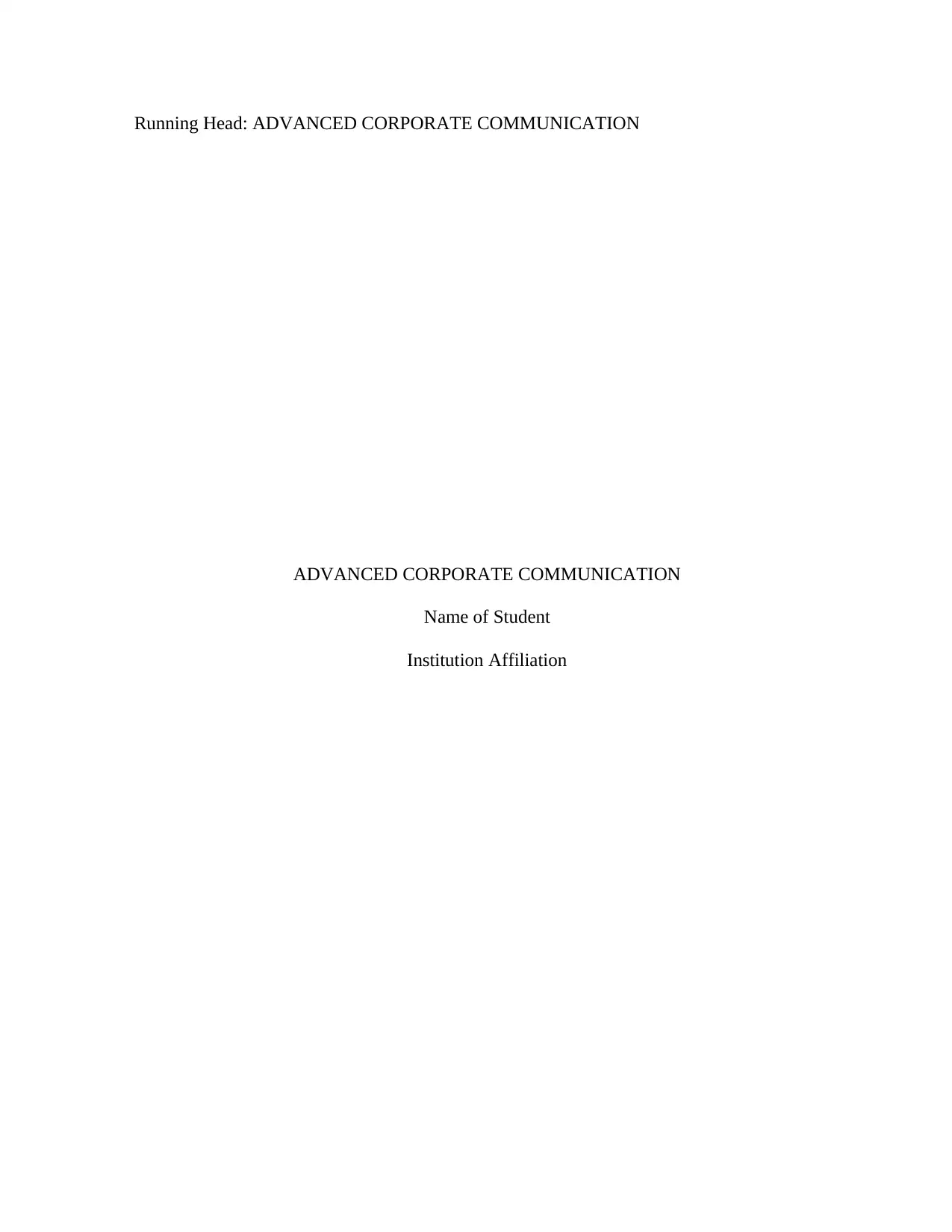
Running Head: ADVANCED CORPORATE COMMUNICATION
ADVANCED CORPORATE COMMUNICATION
Name of Student
Institution Affiliation
ADVANCED CORPORATE COMMUNICATION
Name of Student
Institution Affiliation
Secure Best Marks with AI Grader
Need help grading? Try our AI Grader for instant feedback on your assignments.
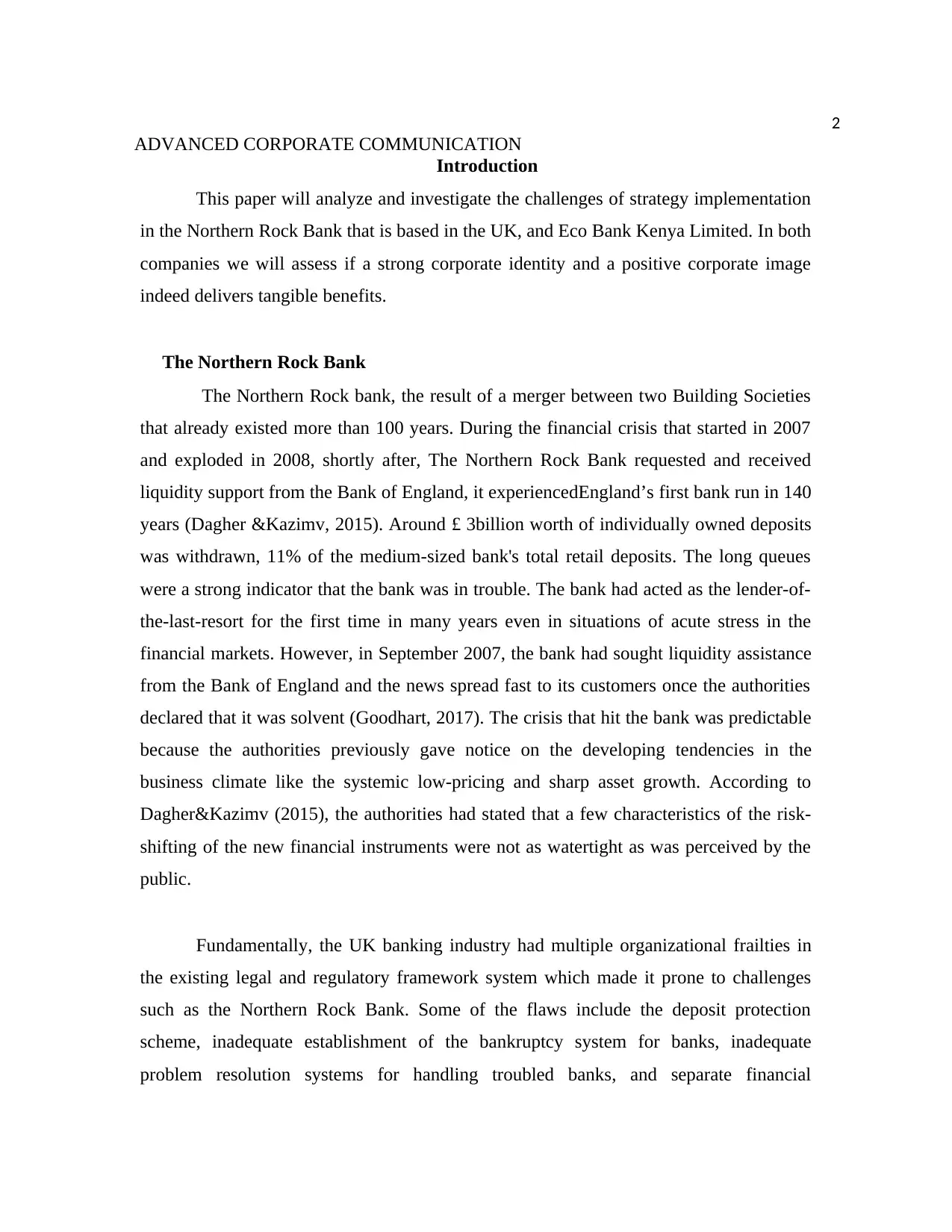
2
ADVANCED CORPORATE COMMUNICATION
Introduction
This paper will analyze and investigate the challenges of strategy implementation
in the Northern Rock Bank that is based in the UK, and Eco Bank Kenya Limited. In both
companies we will assess if a strong corporate identity and a positive corporate image
indeed delivers tangible benefits.
The Northern Rock Bank
The Northern Rock bank, the result of a merger between two Building Societies
that already existed more than 100 years. During the financial crisis that started in 2007
and exploded in 2008, shortly after, The Northern Rock Bank requested and received
liquidity support from the Bank of England, it experiencedEngland’s first bank run in 140
years (Dagher &Kazimv, 2015). Around £ 3billion worth of individually owned deposits
was withdrawn, 11% of the medium-sized bank's total retail deposits. The long queues
were a strong indicator that the bank was in trouble. The bank had acted as the lender-of-
the-last-resort for the first time in many years even in situations of acute stress in the
financial markets. However, in September 2007, the bank had sought liquidity assistance
from the Bank of England and the news spread fast to its customers once the authorities
declared that it was solvent (Goodhart, 2017). The crisis that hit the bank was predictable
because the authorities previously gave notice on the developing tendencies in the
business climate like the systemic low-pricing and sharp asset growth. According to
Dagher&Kazimv (2015), the authorities had stated that a few characteristics of the risk-
shifting of the new financial instruments were not as watertight as was perceived by the
public.
Fundamentally, the UK banking industry had multiple organizational frailties in
the existing legal and regulatory framework system which made it prone to challenges
such as the Northern Rock Bank. Some of the flaws include the deposit protection
scheme, inadequate establishment of the bankruptcy system for banks, inadequate
problem resolution systems for handling troubled banks, and separate financial
ADVANCED CORPORATE COMMUNICATION
Introduction
This paper will analyze and investigate the challenges of strategy implementation
in the Northern Rock Bank that is based in the UK, and Eco Bank Kenya Limited. In both
companies we will assess if a strong corporate identity and a positive corporate image
indeed delivers tangible benefits.
The Northern Rock Bank
The Northern Rock bank, the result of a merger between two Building Societies
that already existed more than 100 years. During the financial crisis that started in 2007
and exploded in 2008, shortly after, The Northern Rock Bank requested and received
liquidity support from the Bank of England, it experiencedEngland’s first bank run in 140
years (Dagher &Kazimv, 2015). Around £ 3billion worth of individually owned deposits
was withdrawn, 11% of the medium-sized bank's total retail deposits. The long queues
were a strong indicator that the bank was in trouble. The bank had acted as the lender-of-
the-last-resort for the first time in many years even in situations of acute stress in the
financial markets. However, in September 2007, the bank had sought liquidity assistance
from the Bank of England and the news spread fast to its customers once the authorities
declared that it was solvent (Goodhart, 2017). The crisis that hit the bank was predictable
because the authorities previously gave notice on the developing tendencies in the
business climate like the systemic low-pricing and sharp asset growth. According to
Dagher&Kazimv (2015), the authorities had stated that a few characteristics of the risk-
shifting of the new financial instruments were not as watertight as was perceived by the
public.
Fundamentally, the UK banking industry had multiple organizational frailties in
the existing legal and regulatory framework system which made it prone to challenges
such as the Northern Rock Bank. Some of the flaws include the deposit protection
scheme, inadequate establishment of the bankruptcy system for banks, inadequate
problem resolution systems for handling troubled banks, and separate financial
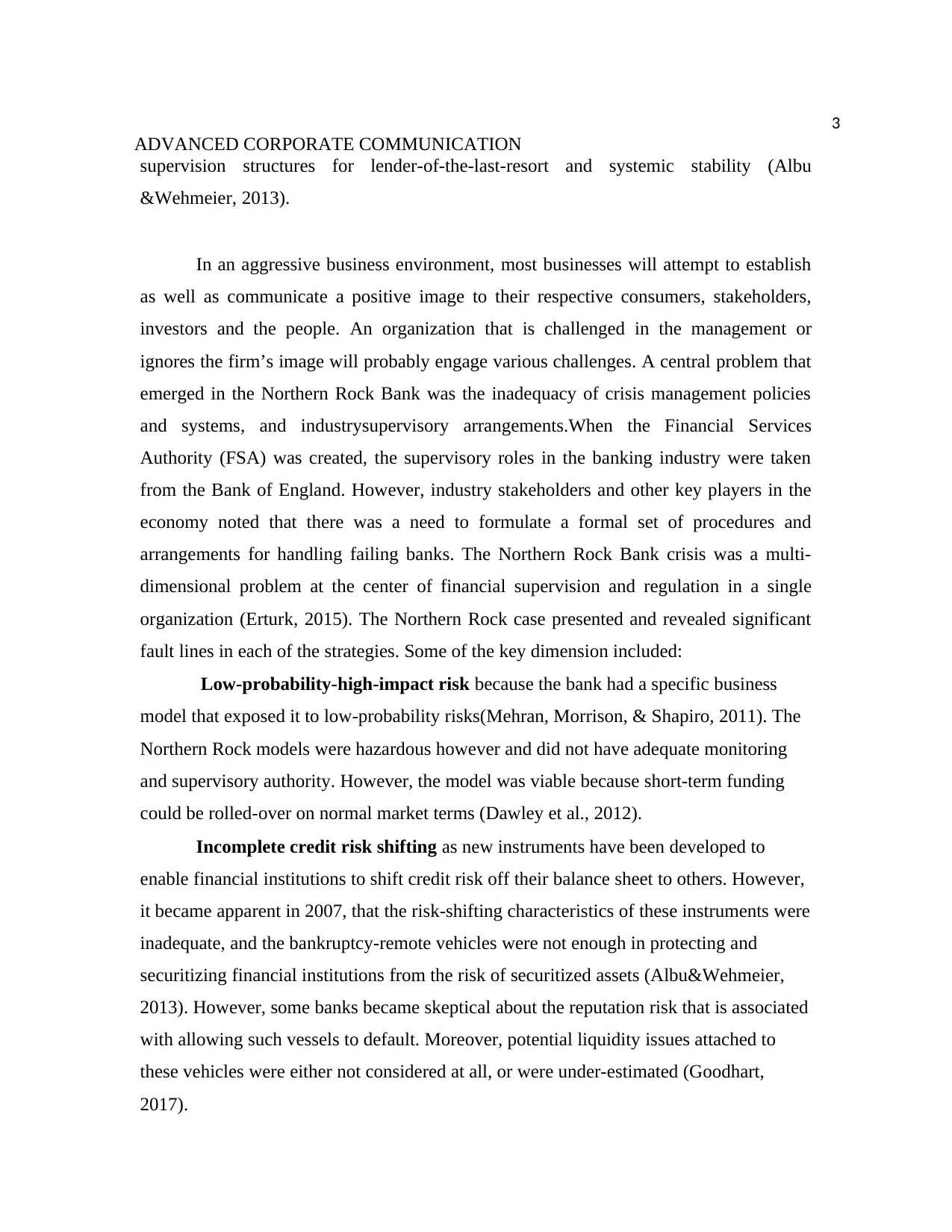
3
ADVANCED CORPORATE COMMUNICATION
supervision structures for lender-of-the-last-resort and systemic stability (Albu
&Wehmeier, 2013).
In an aggressive business environment, most businesses will attempt to establish
as well as communicate a positive image to their respective consumers, stakeholders,
investors and the people. An organization that is challenged in the management or
ignores the firm’s image will probably engage various challenges. A central problem that
emerged in the Northern Rock Bank was the inadequacy of crisis management policies
and systems, and industrysupervisory arrangements.When the Financial Services
Authority (FSA) was created, the supervisory roles in the banking industry were taken
from the Bank of England. However, industry stakeholders and other key players in the
economy noted that there was a need to formulate a formal set of procedures and
arrangements for handling failing banks. The Northern Rock Bank crisis was a multi-
dimensional problem at the center of financial supervision and regulation in a single
organization (Erturk, 2015). The Northern Rock case presented and revealed significant
fault lines in each of the strategies. Some of the key dimension included:
Low-probability-high-impact risk because the bank had a specific business
model that exposed it to low-probability risks(Mehran, Morrison, & Shapiro, 2011). The
Northern Rock models were hazardous however and did not have adequate monitoring
and supervisory authority. However, the model was viable because short-term funding
could be rolled-over on normal market terms (Dawley et al., 2012).
Incomplete credit risk shifting as new instruments have been developed to
enable financial institutions to shift credit risk off their balance sheet to others. However,
it became apparent in 2007, that the risk-shifting characteristics of these instruments were
inadequate, and the bankruptcy-remote vehicles were not enough in protecting and
securitizing financial institutions from the risk of securitized assets (Albu&Wehmeier,
2013). However, some banks became skeptical about the reputation risk that is associated
with allowing such vessels to default. Moreover, potential liquidity issues attached to
these vehicles were either not considered at all, or were under-estimated (Goodhart,
2017).
ADVANCED CORPORATE COMMUNICATION
supervision structures for lender-of-the-last-resort and systemic stability (Albu
&Wehmeier, 2013).
In an aggressive business environment, most businesses will attempt to establish
as well as communicate a positive image to their respective consumers, stakeholders,
investors and the people. An organization that is challenged in the management or
ignores the firm’s image will probably engage various challenges. A central problem that
emerged in the Northern Rock Bank was the inadequacy of crisis management policies
and systems, and industrysupervisory arrangements.When the Financial Services
Authority (FSA) was created, the supervisory roles in the banking industry were taken
from the Bank of England. However, industry stakeholders and other key players in the
economy noted that there was a need to formulate a formal set of procedures and
arrangements for handling failing banks. The Northern Rock Bank crisis was a multi-
dimensional problem at the center of financial supervision and regulation in a single
organization (Erturk, 2015). The Northern Rock case presented and revealed significant
fault lines in each of the strategies. Some of the key dimension included:
Low-probability-high-impact risk because the bank had a specific business
model that exposed it to low-probability risks(Mehran, Morrison, & Shapiro, 2011). The
Northern Rock models were hazardous however and did not have adequate monitoring
and supervisory authority. However, the model was viable because short-term funding
could be rolled-over on normal market terms (Dawley et al., 2012).
Incomplete credit risk shifting as new instruments have been developed to
enable financial institutions to shift credit risk off their balance sheet to others. However,
it became apparent in 2007, that the risk-shifting characteristics of these instruments were
inadequate, and the bankruptcy-remote vehicles were not enough in protecting and
securitizing financial institutions from the risk of securitized assets (Albu&Wehmeier,
2013). However, some banks became skeptical about the reputation risk that is associated
with allowing such vessels to default. Moreover, potential liquidity issues attached to
these vehicles were either not considered at all, or were under-estimated (Goodhart,
2017).
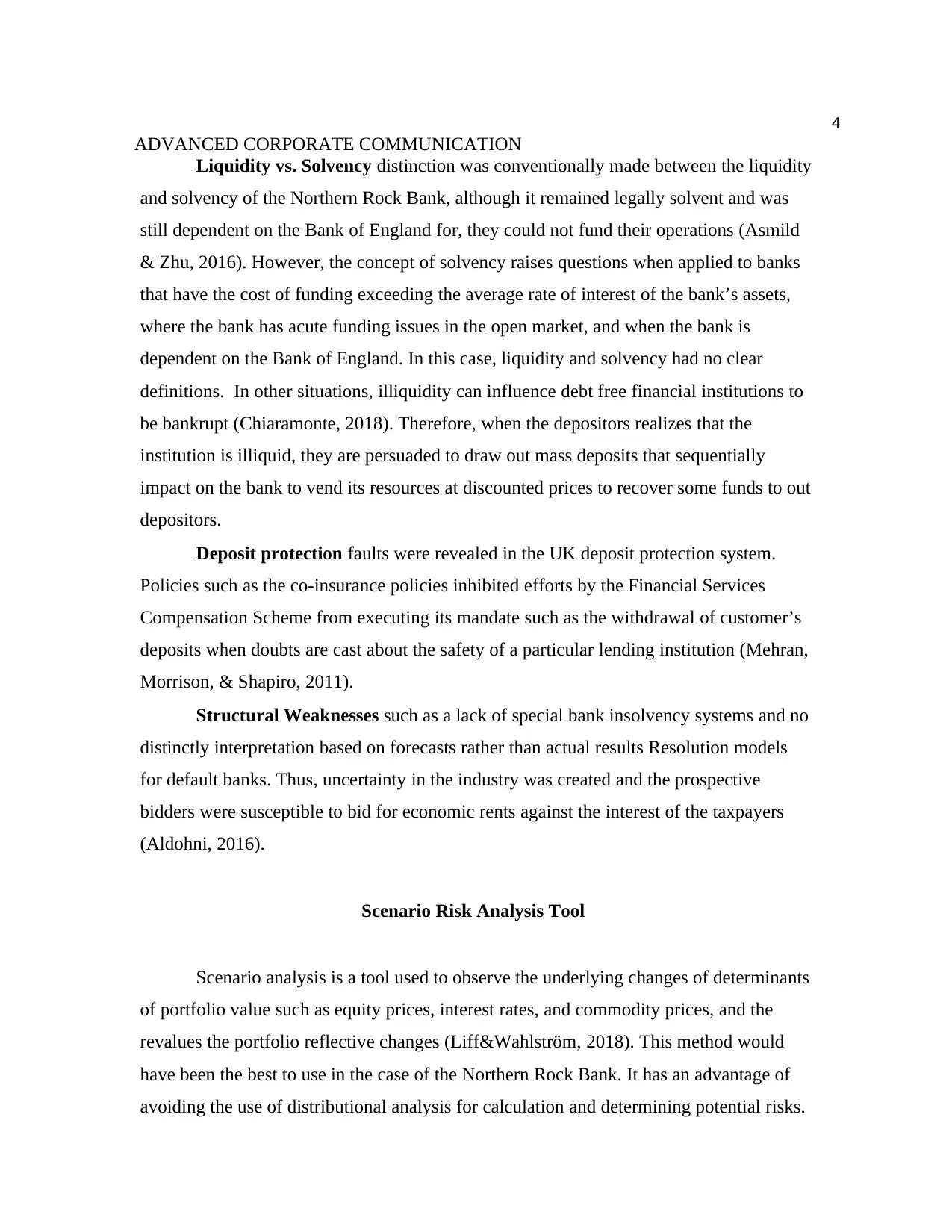
4
ADVANCED CORPORATE COMMUNICATION
Liquidity vs. Solvency distinction was conventionally made between the liquidity
and solvency of the Northern Rock Bank, although it remained legally solvent and was
still dependent on the Bank of England for, they could not fund their operations (Asmild
& Zhu, 2016). However, the concept of solvency raises questions when applied to banks
that have the cost of funding exceeding the average rate of interest of the bank’s assets,
where the bank has acute funding issues in the open market, and when the bank is
dependent on the Bank of England. In this case, liquidity and solvency had no clear
definitions. In other situations, illiquidity can influence debt free financial institutions to
be bankrupt (Chiaramonte, 2018). Therefore, when the depositors realizes that the
institution is illiquid, they are persuaded to draw out mass deposits that sequentially
impact on the bank to vend its resources at discounted prices to recover some funds to out
depositors.
Deposit protection faults were revealed in the UK deposit protection system.
Policies such as the co-insurance policies inhibited efforts by the Financial Services
Compensation Scheme from executing its mandate such as the withdrawal of customer’s
deposits when doubts are cast about the safety of a particular lending institution (Mehran,
Morrison, & Shapiro, 2011).
Structural Weaknesses such as a lack of special bank insolvency systems and no
distinctly interpretation based on forecasts rather than actual results Resolution models
for default banks. Thus, uncertainty in the industry was created and the prospective
bidders were susceptible to bid for economic rents against the interest of the taxpayers
(Aldohni, 2016).
Scenario Risk Analysis Tool
Scenario analysis is a tool used to observe the underlying changes of determinants
of portfolio value such as equity prices, interest rates, and commodity prices, and the
revalues the portfolio reflective changes (Liff&Wahlström, 2018). This method would
have been the best to use in the case of the Northern Rock Bank. It has an advantage of
avoiding the use of distributional analysis for calculation and determining potential risks.
ADVANCED CORPORATE COMMUNICATION
Liquidity vs. Solvency distinction was conventionally made between the liquidity
and solvency of the Northern Rock Bank, although it remained legally solvent and was
still dependent on the Bank of England for, they could not fund their operations (Asmild
& Zhu, 2016). However, the concept of solvency raises questions when applied to banks
that have the cost of funding exceeding the average rate of interest of the bank’s assets,
where the bank has acute funding issues in the open market, and when the bank is
dependent on the Bank of England. In this case, liquidity and solvency had no clear
definitions. In other situations, illiquidity can influence debt free financial institutions to
be bankrupt (Chiaramonte, 2018). Therefore, when the depositors realizes that the
institution is illiquid, they are persuaded to draw out mass deposits that sequentially
impact on the bank to vend its resources at discounted prices to recover some funds to out
depositors.
Deposit protection faults were revealed in the UK deposit protection system.
Policies such as the co-insurance policies inhibited efforts by the Financial Services
Compensation Scheme from executing its mandate such as the withdrawal of customer’s
deposits when doubts are cast about the safety of a particular lending institution (Mehran,
Morrison, & Shapiro, 2011).
Structural Weaknesses such as a lack of special bank insolvency systems and no
distinctly interpretation based on forecasts rather than actual results Resolution models
for default banks. Thus, uncertainty in the industry was created and the prospective
bidders were susceptible to bid for economic rents against the interest of the taxpayers
(Aldohni, 2016).
Scenario Risk Analysis Tool
Scenario analysis is a tool used to observe the underlying changes of determinants
of portfolio value such as equity prices, interest rates, and commodity prices, and the
revalues the portfolio reflective changes (Liff&Wahlström, 2018). This method would
have been the best to use in the case of the Northern Rock Bank. It has an advantage of
avoiding the use of distributional analysis for calculation and determining potential risks.
Secure Best Marks with AI Grader
Need help grading? Try our AI Grader for instant feedback on your assignments.
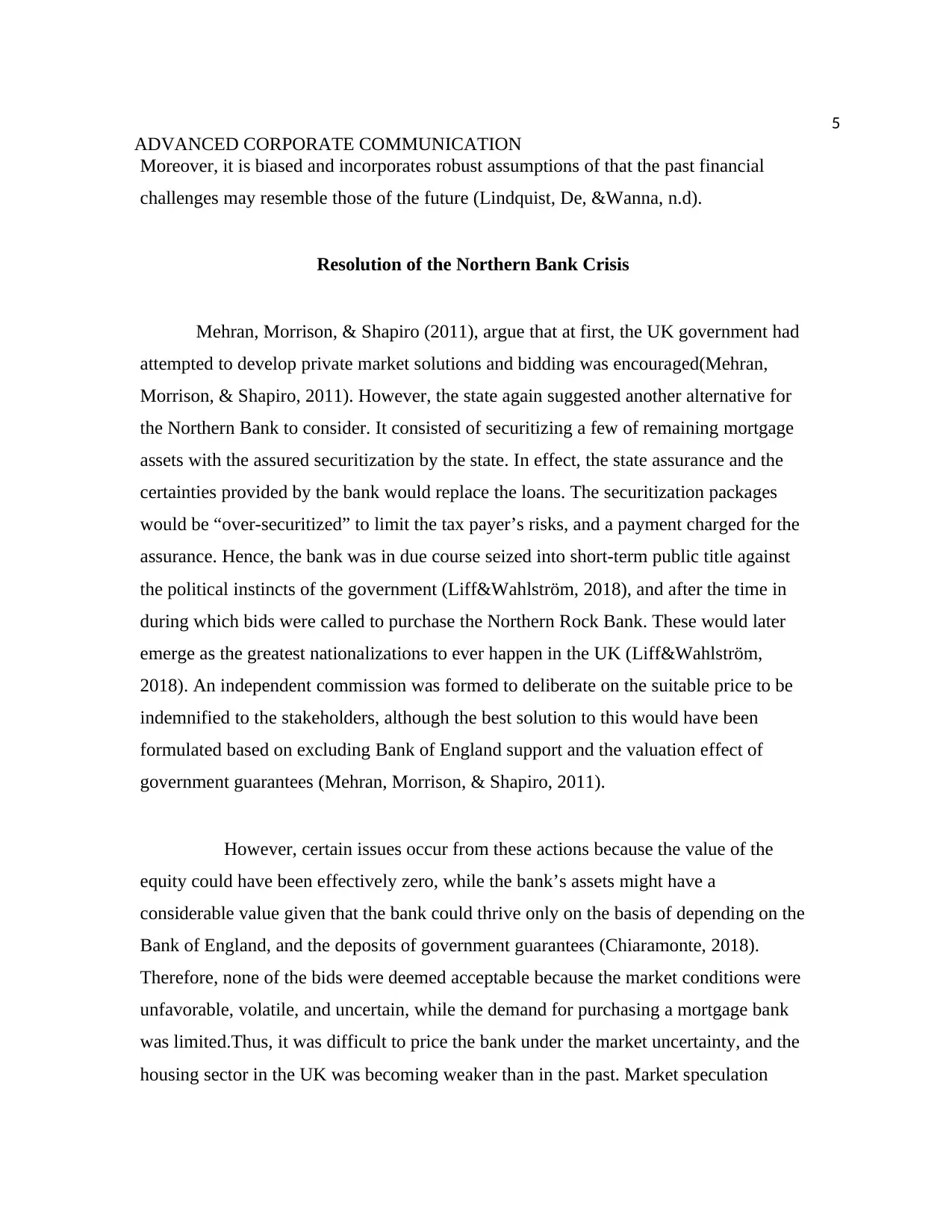
5
ADVANCED CORPORATE COMMUNICATION
Moreover, it is biased and incorporates robust assumptions of that the past financial
challenges may resemble those of the future (Lindquist, De, &Wanna, n.d).
Resolution of the Northern Bank Crisis
Mehran, Morrison, & Shapiro (2011), argue that at first, the UK government had
attempted to develop private market solutions and bidding was encouraged(Mehran,
Morrison, & Shapiro, 2011). However, the state again suggested another alternative for
the Northern Bank to consider. It consisted of securitizing a few of remaining mortgage
assets with the assured securitization by the state. In effect, the state assurance and the
certainties provided by the bank would replace the loans. The securitization packages
would be “over-securitized” to limit the tax payer’s risks, and a payment charged for the
assurance. Hence, the bank was in due course seized into short-term public title against
the political instincts of the government (Liff&Wahlström, 2018), and after the time in
during which bids were called to purchase the Northern Rock Bank. These would later
emerge as the greatest nationalizations to ever happen in the UK (Liff&Wahlström,
2018). An independent commission was formed to deliberate on the suitable price to be
indemnified to the stakeholders, although the best solution to this would have been
formulated based on excluding Bank of England support and the valuation effect of
government guarantees (Mehran, Morrison, & Shapiro, 2011).
However, certain issues occur from these actions because the value of the
equity could have been effectively zero, while the bank’s assets might have a
considerable value given that the bank could thrive only on the basis of depending on the
Bank of England, and the deposits of government guarantees (Chiaramonte, 2018).
Therefore, none of the bids were deemed acceptable because the market conditions were
unfavorable, volatile, and uncertain, while the demand for purchasing a mortgage bank
was limited.Thus, it was difficult to price the bank under the market uncertainty, and the
housing sector in the UK was becoming weaker than in the past. Market speculation
ADVANCED CORPORATE COMMUNICATION
Moreover, it is biased and incorporates robust assumptions of that the past financial
challenges may resemble those of the future (Lindquist, De, &Wanna, n.d).
Resolution of the Northern Bank Crisis
Mehran, Morrison, & Shapiro (2011), argue that at first, the UK government had
attempted to develop private market solutions and bidding was encouraged(Mehran,
Morrison, & Shapiro, 2011). However, the state again suggested another alternative for
the Northern Bank to consider. It consisted of securitizing a few of remaining mortgage
assets with the assured securitization by the state. In effect, the state assurance and the
certainties provided by the bank would replace the loans. The securitization packages
would be “over-securitized” to limit the tax payer’s risks, and a payment charged for the
assurance. Hence, the bank was in due course seized into short-term public title against
the political instincts of the government (Liff&Wahlström, 2018), and after the time in
during which bids were called to purchase the Northern Rock Bank. These would later
emerge as the greatest nationalizations to ever happen in the UK (Liff&Wahlström,
2018). An independent commission was formed to deliberate on the suitable price to be
indemnified to the stakeholders, although the best solution to this would have been
formulated based on excluding Bank of England support and the valuation effect of
government guarantees (Mehran, Morrison, & Shapiro, 2011).
However, certain issues occur from these actions because the value of the
equity could have been effectively zero, while the bank’s assets might have a
considerable value given that the bank could thrive only on the basis of depending on the
Bank of England, and the deposits of government guarantees (Chiaramonte, 2018).
Therefore, none of the bids were deemed acceptable because the market conditions were
unfavorable, volatile, and uncertain, while the demand for purchasing a mortgage bank
was limited.Thus, it was difficult to price the bank under the market uncertainty, and the
housing sector in the UK was becoming weaker than in the past. Market speculation
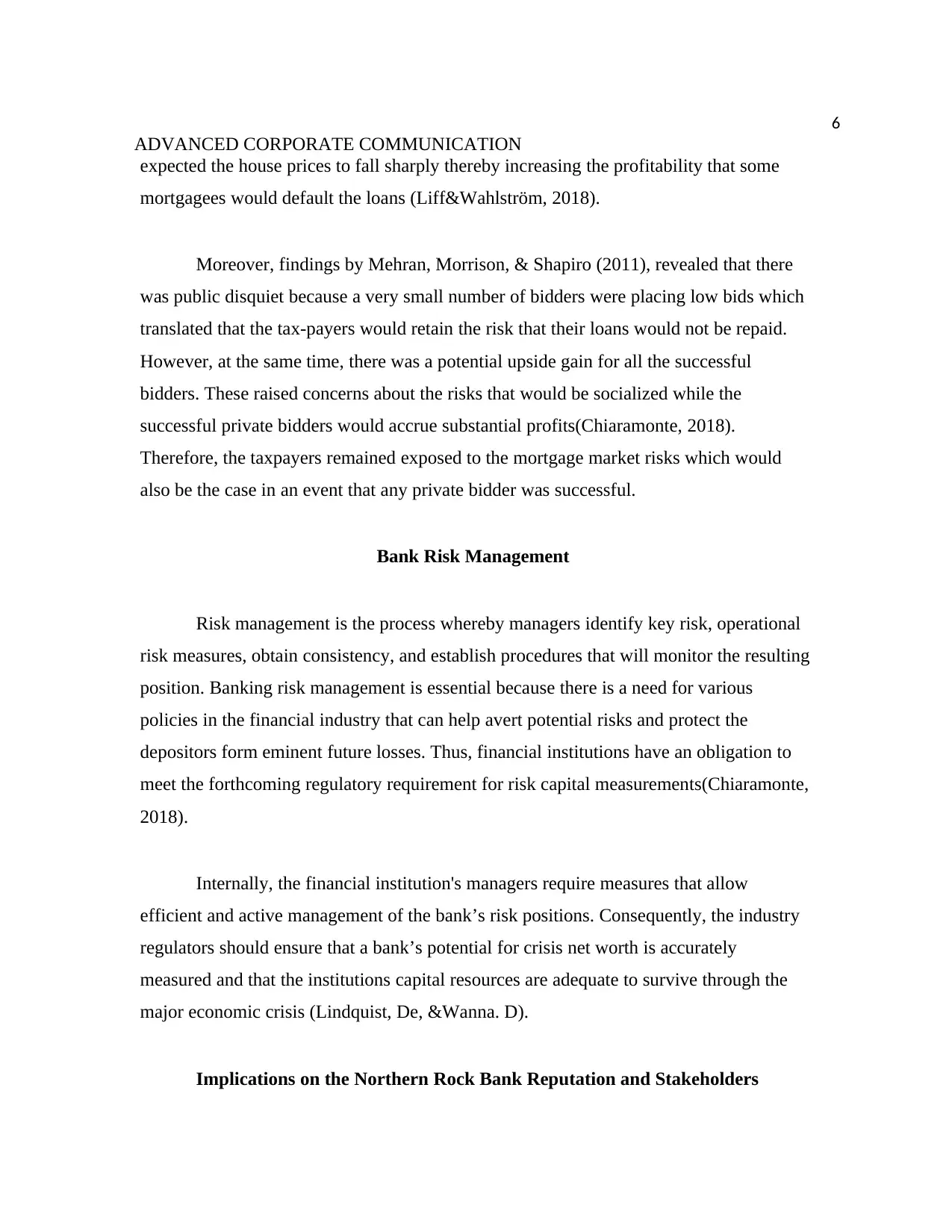
6
ADVANCED CORPORATE COMMUNICATION
expected the house prices to fall sharply thereby increasing the profitability that some
mortgagees would default the loans (Liff&Wahlström, 2018).
Moreover, findings by Mehran, Morrison, & Shapiro (2011), revealed that there
was public disquiet because a very small number of bidders were placing low bids which
translated that the tax-payers would retain the risk that their loans would not be repaid.
However, at the same time, there was a potential upside gain for all the successful
bidders. These raised concerns about the risks that would be socialized while the
successful private bidders would accrue substantial profits(Chiaramonte, 2018).
Therefore, the taxpayers remained exposed to the mortgage market risks which would
also be the case in an event that any private bidder was successful.
Bank Risk Management
Risk management is the process whereby managers identify key risk, operational
risk measures, obtain consistency, and establish procedures that will monitor the resulting
position. Banking risk management is essential because there is a need for various
policies in the financial industry that can help avert potential risks and protect the
depositors form eminent future losses. Thus, financial institutions have an obligation to
meet the forthcoming regulatory requirement for risk capital measurements(Chiaramonte,
2018).
Internally, the financial institution's managers require measures that allow
efficient and active management of the bank’s risk positions. Consequently, the industry
regulators should ensure that a bank’s potential for crisis net worth is accurately
measured and that the institutions capital resources are adequate to survive through the
major economic crisis (Lindquist, De, &Wanna. D).
Implications on the Northern Rock Bank Reputation and Stakeholders
ADVANCED CORPORATE COMMUNICATION
expected the house prices to fall sharply thereby increasing the profitability that some
mortgagees would default the loans (Liff&Wahlström, 2018).
Moreover, findings by Mehran, Morrison, & Shapiro (2011), revealed that there
was public disquiet because a very small number of bidders were placing low bids which
translated that the tax-payers would retain the risk that their loans would not be repaid.
However, at the same time, there was a potential upside gain for all the successful
bidders. These raised concerns about the risks that would be socialized while the
successful private bidders would accrue substantial profits(Chiaramonte, 2018).
Therefore, the taxpayers remained exposed to the mortgage market risks which would
also be the case in an event that any private bidder was successful.
Bank Risk Management
Risk management is the process whereby managers identify key risk, operational
risk measures, obtain consistency, and establish procedures that will monitor the resulting
position. Banking risk management is essential because there is a need for various
policies in the financial industry that can help avert potential risks and protect the
depositors form eminent future losses. Thus, financial institutions have an obligation to
meet the forthcoming regulatory requirement for risk capital measurements(Chiaramonte,
2018).
Internally, the financial institution's managers require measures that allow
efficient and active management of the bank’s risk positions. Consequently, the industry
regulators should ensure that a bank’s potential for crisis net worth is accurately
measured and that the institutions capital resources are adequate to survive through the
major economic crisis (Lindquist, De, &Wanna. D).
Implications on the Northern Rock Bank Reputation and Stakeholders
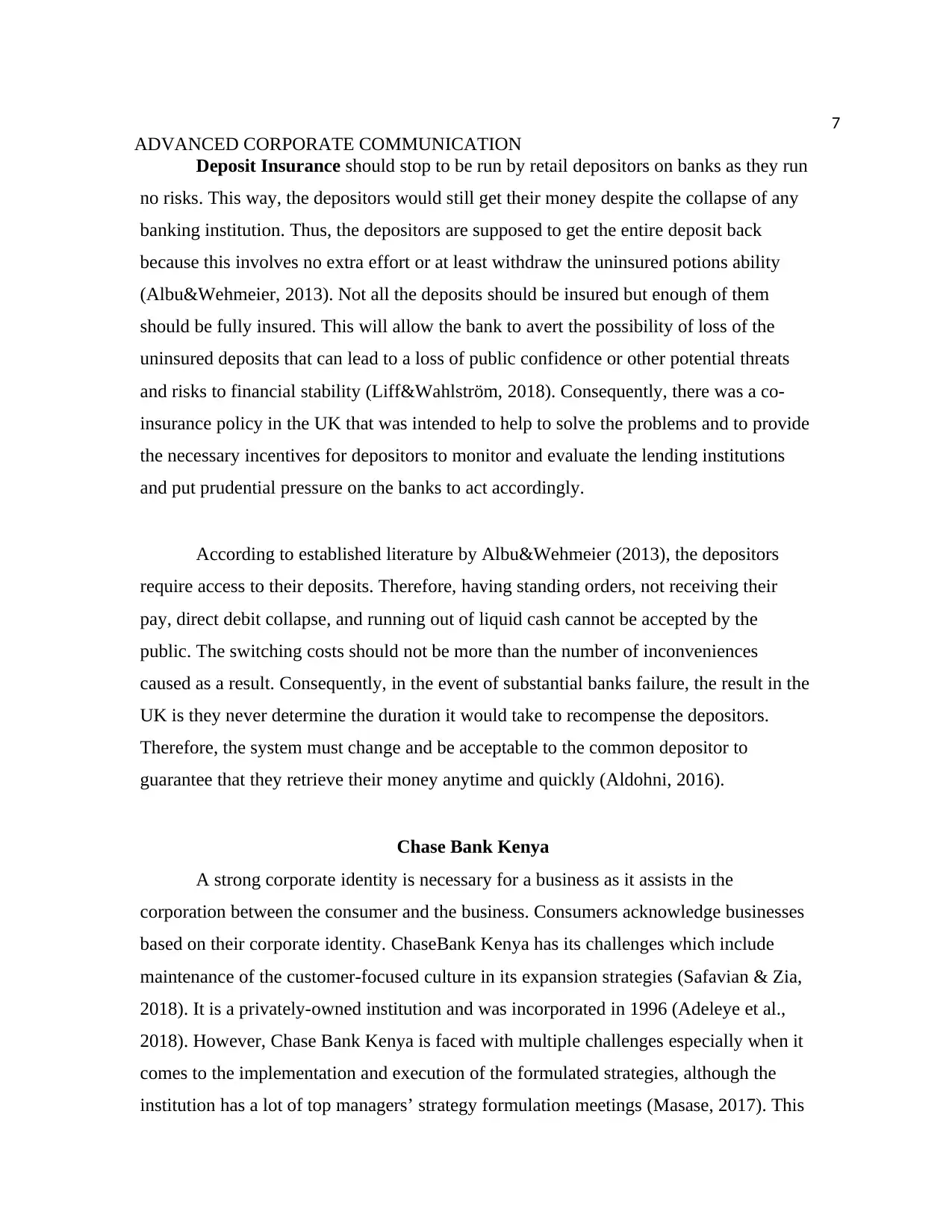
7
ADVANCED CORPORATE COMMUNICATION
Deposit Insurance should stop to be run by retail depositors on banks as they run
no risks. This way, the depositors would still get their money despite the collapse of any
banking institution. Thus, the depositors are supposed to get the entire deposit back
because this involves no extra effort or at least withdraw the uninsured potions ability
(Albu&Wehmeier, 2013). Not all the deposits should be insured but enough of them
should be fully insured. This will allow the bank to avert the possibility of loss of the
uninsured deposits that can lead to a loss of public confidence or other potential threats
and risks to financial stability (Liff&Wahlström, 2018). Consequently, there was a co-
insurance policy in the UK that was intended to help to solve the problems and to provide
the necessary incentives for depositors to monitor and evaluate the lending institutions
and put prudential pressure on the banks to act accordingly.
According to established literature by Albu&Wehmeier (2013), the depositors
require access to their deposits. Therefore, having standing orders, not receiving their
pay, direct debit collapse, and running out of liquid cash cannot be accepted by the
public. The switching costs should not be more than the number of inconveniences
caused as a result. Consequently, in the event of substantial banks failure, the result in the
UK is they never determine the duration it would take to recompense the depositors.
Therefore, the system must change and be acceptable to the common depositor to
guarantee that they retrieve their money anytime and quickly (Aldohni, 2016).
Chase Bank Kenya
A strong corporate identity is necessary for a business as it assists in the
corporation between the consumer and the business. Consumers acknowledge businesses
based on their corporate identity. ChaseBank Kenya has its challenges which include
maintenance of the customer-focused culture in its expansion strategies (Safavian & Zia,
2018). It is a privately-owned institution and was incorporated in 1996 (Adeleye et al.,
2018). However, Chase Bank Kenya is faced with multiple challenges especially when it
comes to the implementation and execution of the formulated strategies, although the
institution has a lot of top managers’ strategy formulation meetings (Masase, 2017). This
ADVANCED CORPORATE COMMUNICATION
Deposit Insurance should stop to be run by retail depositors on banks as they run
no risks. This way, the depositors would still get their money despite the collapse of any
banking institution. Thus, the depositors are supposed to get the entire deposit back
because this involves no extra effort or at least withdraw the uninsured potions ability
(Albu&Wehmeier, 2013). Not all the deposits should be insured but enough of them
should be fully insured. This will allow the bank to avert the possibility of loss of the
uninsured deposits that can lead to a loss of public confidence or other potential threats
and risks to financial stability (Liff&Wahlström, 2018). Consequently, there was a co-
insurance policy in the UK that was intended to help to solve the problems and to provide
the necessary incentives for depositors to monitor and evaluate the lending institutions
and put prudential pressure on the banks to act accordingly.
According to established literature by Albu&Wehmeier (2013), the depositors
require access to their deposits. Therefore, having standing orders, not receiving their
pay, direct debit collapse, and running out of liquid cash cannot be accepted by the
public. The switching costs should not be more than the number of inconveniences
caused as a result. Consequently, in the event of substantial banks failure, the result in the
UK is they never determine the duration it would take to recompense the depositors.
Therefore, the system must change and be acceptable to the common depositor to
guarantee that they retrieve their money anytime and quickly (Aldohni, 2016).
Chase Bank Kenya
A strong corporate identity is necessary for a business as it assists in the
corporation between the consumer and the business. Consumers acknowledge businesses
based on their corporate identity. ChaseBank Kenya has its challenges which include
maintenance of the customer-focused culture in its expansion strategies (Safavian & Zia,
2018). It is a privately-owned institution and was incorporated in 1996 (Adeleye et al.,
2018). However, Chase Bank Kenya is faced with multiple challenges especially when it
comes to the implementation and execution of the formulated strategies, although the
institution has a lot of top managers’ strategy formulation meetings (Masase, 2017). This
Paraphrase This Document
Need a fresh take? Get an instant paraphrase of this document with our AI Paraphraser
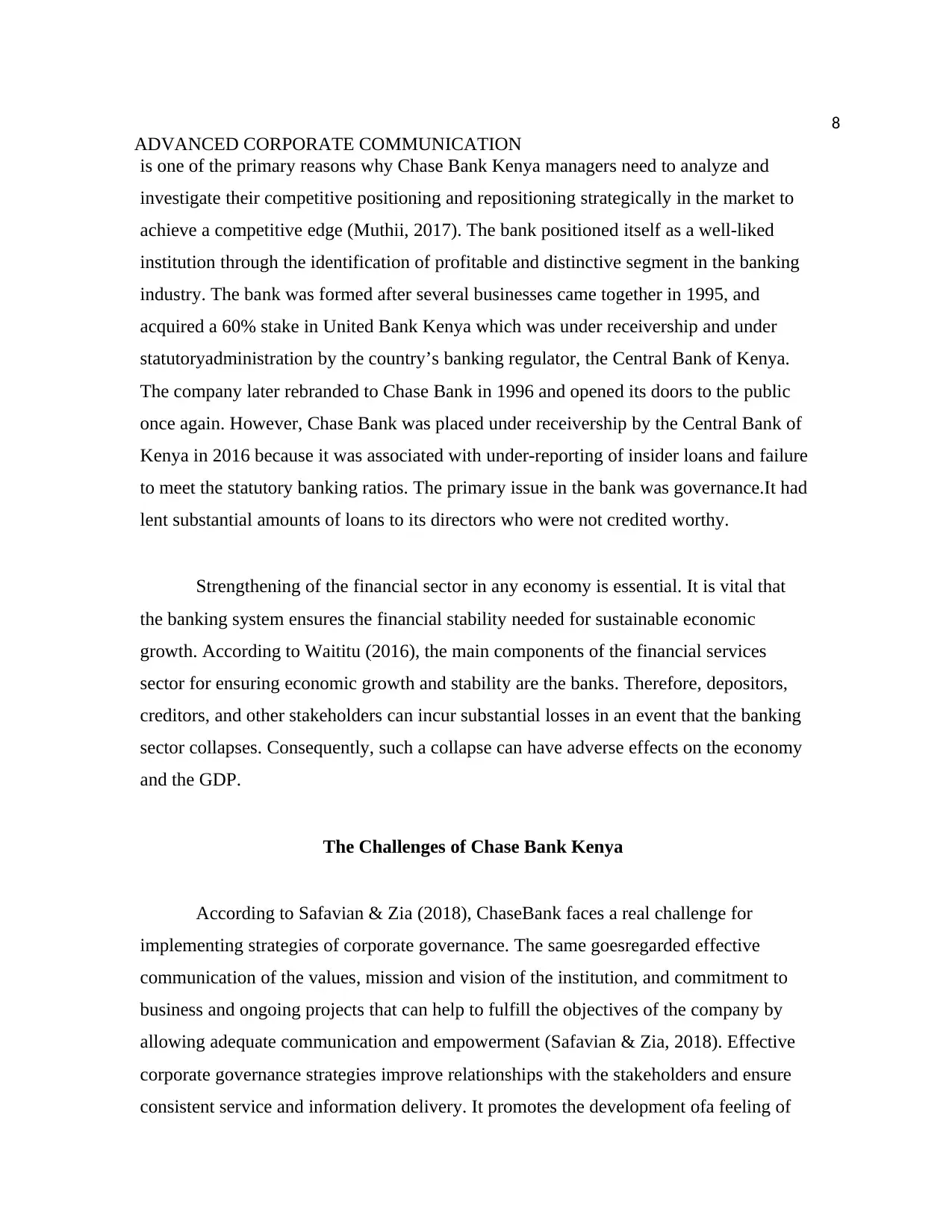
8
ADVANCED CORPORATE COMMUNICATION
is one of the primary reasons why Chase Bank Kenya managers need to analyze and
investigate their competitive positioning and repositioning strategically in the market to
achieve a competitive edge (Muthii, 2017). The bank positioned itself as a well-liked
institution through the identification of profitable and distinctive segment in the banking
industry. The bank was formed after several businesses came together in 1995, and
acquired a 60% stake in United Bank Kenya which was under receivership and under
statutoryadministration by the country’s banking regulator, the Central Bank of Kenya.
The company later rebranded to Chase Bank in 1996 and opened its doors to the public
once again. However, Chase Bank was placed under receivership by the Central Bank of
Kenya in 2016 because it was associated with under-reporting of insider loans and failure
to meet the statutory banking ratios. The primary issue in the bank was governance.It had
lent substantial amounts of loans to its directors who were not credited worthy.
Strengthening of the financial sector in any economy is essential. It is vital that
the banking system ensures the financial stability needed for sustainable economic
growth. According to Waititu (2016), the main components of the financial services
sector for ensuring economic growth and stability are the banks. Therefore, depositors,
creditors, and other stakeholders can incur substantial losses in an event that the banking
sector collapses. Consequently, such a collapse can have adverse effects on the economy
and the GDP.
The Challenges of Chase Bank Kenya
According to Safavian & Zia (2018), ChaseBank faces a real challenge for
implementing strategies of corporate governance. The same goesregarded effective
communication of the values, mission and vision of the institution, and commitment to
business and ongoing projects that can help to fulfill the objectives of the company by
allowing adequate communication and empowerment (Safavian & Zia, 2018). Effective
corporate governance strategies improve relationships with the stakeholders and ensure
consistent service and information delivery. It promotes the development ofa feeling of
ADVANCED CORPORATE COMMUNICATION
is one of the primary reasons why Chase Bank Kenya managers need to analyze and
investigate their competitive positioning and repositioning strategically in the market to
achieve a competitive edge (Muthii, 2017). The bank positioned itself as a well-liked
institution through the identification of profitable and distinctive segment in the banking
industry. The bank was formed after several businesses came together in 1995, and
acquired a 60% stake in United Bank Kenya which was under receivership and under
statutoryadministration by the country’s banking regulator, the Central Bank of Kenya.
The company later rebranded to Chase Bank in 1996 and opened its doors to the public
once again. However, Chase Bank was placed under receivership by the Central Bank of
Kenya in 2016 because it was associated with under-reporting of insider loans and failure
to meet the statutory banking ratios. The primary issue in the bank was governance.It had
lent substantial amounts of loans to its directors who were not credited worthy.
Strengthening of the financial sector in any economy is essential. It is vital that
the banking system ensures the financial stability needed for sustainable economic
growth. According to Waititu (2016), the main components of the financial services
sector for ensuring economic growth and stability are the banks. Therefore, depositors,
creditors, and other stakeholders can incur substantial losses in an event that the banking
sector collapses. Consequently, such a collapse can have adverse effects on the economy
and the GDP.
The Challenges of Chase Bank Kenya
According to Safavian & Zia (2018), ChaseBank faces a real challenge for
implementing strategies of corporate governance. The same goesregarded effective
communication of the values, mission and vision of the institution, and commitment to
business and ongoing projects that can help to fulfill the objectives of the company by
allowing adequate communication and empowerment (Safavian & Zia, 2018). Effective
corporate governance strategies improve relationships with the stakeholders and ensure
consistent service and information delivery. It promotes the development ofa feeling of
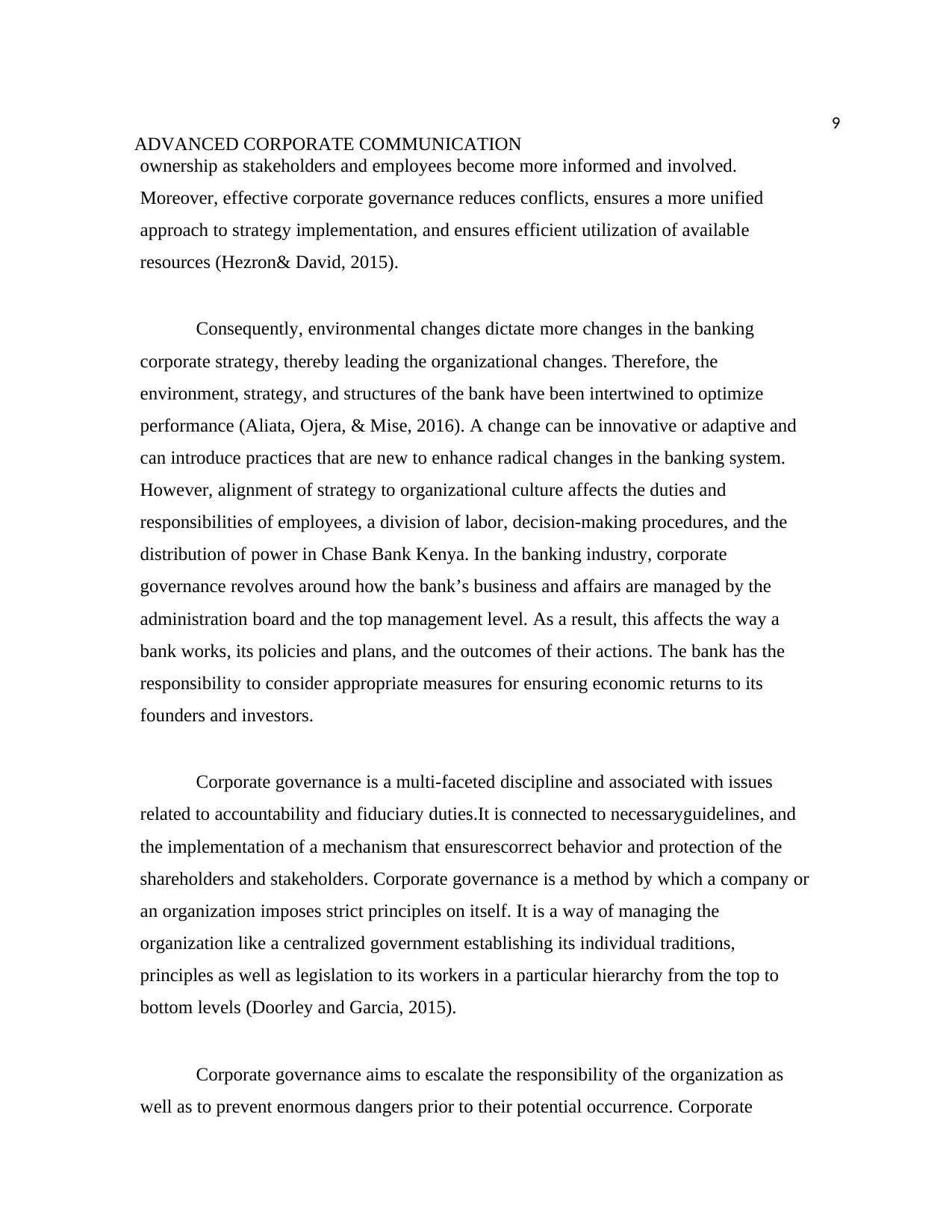
9
ADVANCED CORPORATE COMMUNICATION
ownership as stakeholders and employees become more informed and involved.
Moreover, effective corporate governance reduces conflicts, ensures a more unified
approach to strategy implementation, and ensures efficient utilization of available
resources (Hezron& David, 2015).
Consequently, environmental changes dictate more changes in the banking
corporate strategy, thereby leading the organizational changes. Therefore, the
environment, strategy, and structures of the bank have been intertwined to optimize
performance (Aliata, Ojera, & Mise, 2016). A change can be innovative or adaptive and
can introduce practices that are new to enhance radical changes in the banking system.
However, alignment of strategy to organizational culture affects the duties and
responsibilities of employees, a division of labor, decision-making procedures, and the
distribution of power in Chase Bank Kenya. In the banking industry, corporate
governance revolves around how the bank’s business and affairs are managed by the
administration board and the top management level. As a result, this affects the way a
bank works, its policies and plans, and the outcomes of their actions. The bank has the
responsibility to consider appropriate measures for ensuring economic returns to its
founders and investors.
Corporate governance is a multi-faceted discipline and associated with issues
related to accountability and fiduciary duties.It is connected to necessaryguidelines, and
the implementation of a mechanism that ensurescorrect behavior and protection of the
shareholders and stakeholders. Corporate governance is a method by which a company or
an organization imposes strict principles on itself. It is a way of managing the
organization like a centralized government establishing its individual traditions,
principles as well as legislation to its workers in a particular hierarchy from the top to
bottom levels (Doorley and Garcia, 2015).
Corporate governance aims to escalate the responsibility of the organization as
well as to prevent enormous dangers prior to their potential occurrence. Corporate
ADVANCED CORPORATE COMMUNICATION
ownership as stakeholders and employees become more informed and involved.
Moreover, effective corporate governance reduces conflicts, ensures a more unified
approach to strategy implementation, and ensures efficient utilization of available
resources (Hezron& David, 2015).
Consequently, environmental changes dictate more changes in the banking
corporate strategy, thereby leading the organizational changes. Therefore, the
environment, strategy, and structures of the bank have been intertwined to optimize
performance (Aliata, Ojera, & Mise, 2016). A change can be innovative or adaptive and
can introduce practices that are new to enhance radical changes in the banking system.
However, alignment of strategy to organizational culture affects the duties and
responsibilities of employees, a division of labor, decision-making procedures, and the
distribution of power in Chase Bank Kenya. In the banking industry, corporate
governance revolves around how the bank’s business and affairs are managed by the
administration board and the top management level. As a result, this affects the way a
bank works, its policies and plans, and the outcomes of their actions. The bank has the
responsibility to consider appropriate measures for ensuring economic returns to its
founders and investors.
Corporate governance is a multi-faceted discipline and associated with issues
related to accountability and fiduciary duties.It is connected to necessaryguidelines, and
the implementation of a mechanism that ensurescorrect behavior and protection of the
shareholders and stakeholders. Corporate governance is a method by which a company or
an organization imposes strict principles on itself. It is a way of managing the
organization like a centralized government establishing its individual traditions,
principles as well as legislation to its workers in a particular hierarchy from the top to
bottom levels (Doorley and Garcia, 2015).
Corporate governance aims to escalate the responsibility of the organization as
well as to prevent enormous dangers prior to their potential occurrence. Corporate
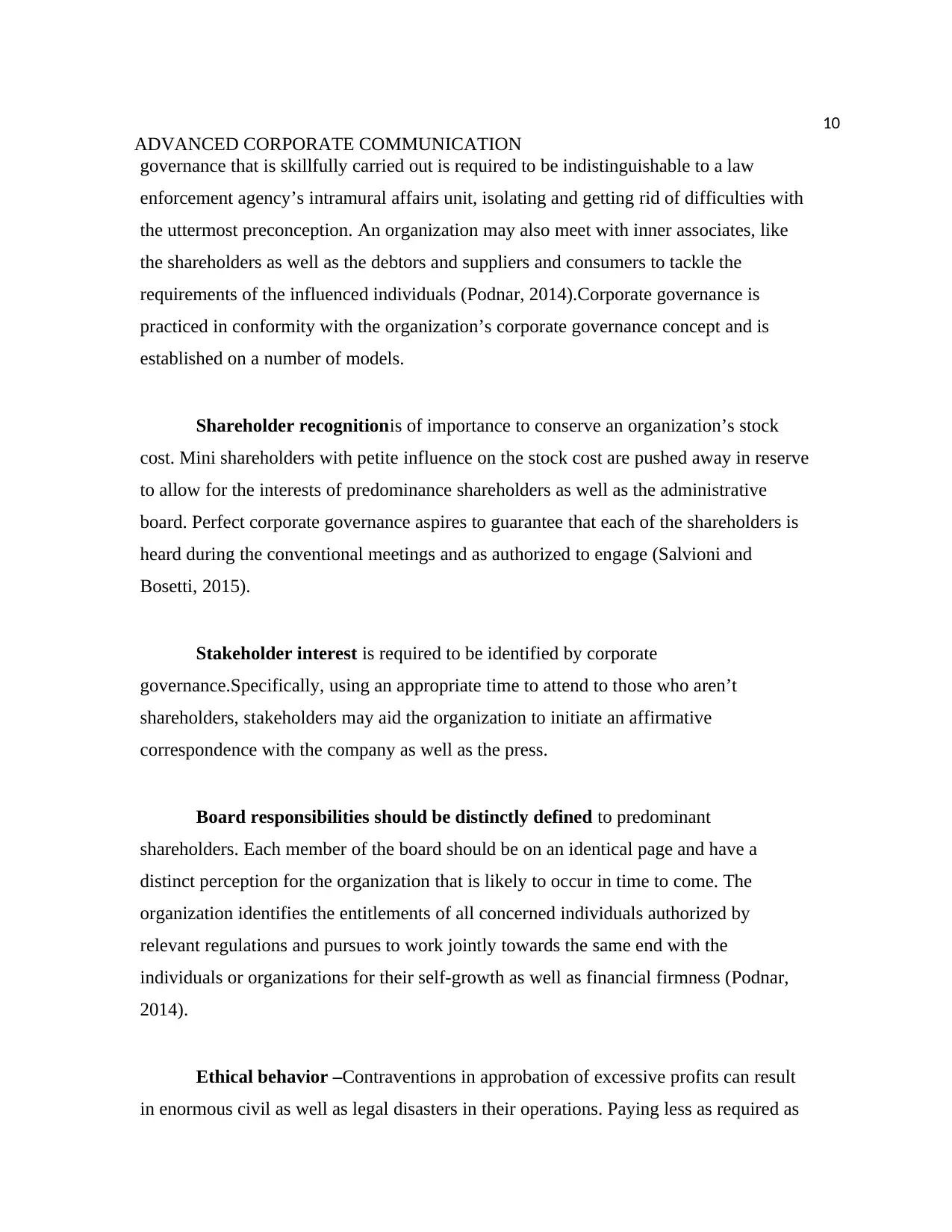
10
ADVANCED CORPORATE COMMUNICATION
governance that is skillfully carried out is required to be indistinguishable to a law
enforcement agency’s intramural affairs unit, isolating and getting rid of difficulties with
the uttermost preconception. An organization may also meet with inner associates, like
the shareholders as well as the debtors and suppliers and consumers to tackle the
requirements of the influenced individuals (Podnar, 2014).Corporate governance is
practiced in conformity with the organization’s corporate governance concept and is
established on a number of models.
Shareholder recognitionis of importance to conserve an organization’s stock
cost. Mini shareholders with petite influence on the stock cost are pushed away in reserve
to allow for the interests of predominance shareholders as well as the administrative
board. Perfect corporate governance aspires to guarantee that each of the shareholders is
heard during the conventional meetings and as authorized to engage (Salvioni and
Bosetti, 2015).
Stakeholder interest is required to be identified by corporate
governance.Specifically, using an appropriate time to attend to those who aren’t
shareholders, stakeholders may aid the organization to initiate an affirmative
correspondence with the company as well as the press.
Board responsibilities should be distinctly defined to predominant
shareholders. Each member of the board should be on an identical page and have a
distinct perception for the organization that is likely to occur in time to come. The
organization identifies the entitlements of all concerned individuals authorized by
relevant regulations and pursues to work jointly towards the same end with the
individuals or organizations for their self-growth as well as financial firmness (Podnar,
2014).
Ethical behavior –Contraventions in approbation of excessive profits can result
in enormous civil as well as legal disasters in their operations. Paying less as required as
ADVANCED CORPORATE COMMUNICATION
governance that is skillfully carried out is required to be indistinguishable to a law
enforcement agency’s intramural affairs unit, isolating and getting rid of difficulties with
the uttermost preconception. An organization may also meet with inner associates, like
the shareholders as well as the debtors and suppliers and consumers to tackle the
requirements of the influenced individuals (Podnar, 2014).Corporate governance is
practiced in conformity with the organization’s corporate governance concept and is
established on a number of models.
Shareholder recognitionis of importance to conserve an organization’s stock
cost. Mini shareholders with petite influence on the stock cost are pushed away in reserve
to allow for the interests of predominance shareholders as well as the administrative
board. Perfect corporate governance aspires to guarantee that each of the shareholders is
heard during the conventional meetings and as authorized to engage (Salvioni and
Bosetti, 2015).
Stakeholder interest is required to be identified by corporate
governance.Specifically, using an appropriate time to attend to those who aren’t
shareholders, stakeholders may aid the organization to initiate an affirmative
correspondence with the company as well as the press.
Board responsibilities should be distinctly defined to predominant
shareholders. Each member of the board should be on an identical page and have a
distinct perception for the organization that is likely to occur in time to come. The
organization identifies the entitlements of all concerned individuals authorized by
relevant regulations and pursues to work jointly towards the same end with the
individuals or organizations for their self-growth as well as financial firmness (Podnar,
2014).
Ethical behavior –Contraventions in approbation of excessive profits can result
in enormous civil as well as legal disasters in their operations. Paying less as required as
Secure Best Marks with AI Grader
Need help grading? Try our AI Grader for instant feedback on your assignments.
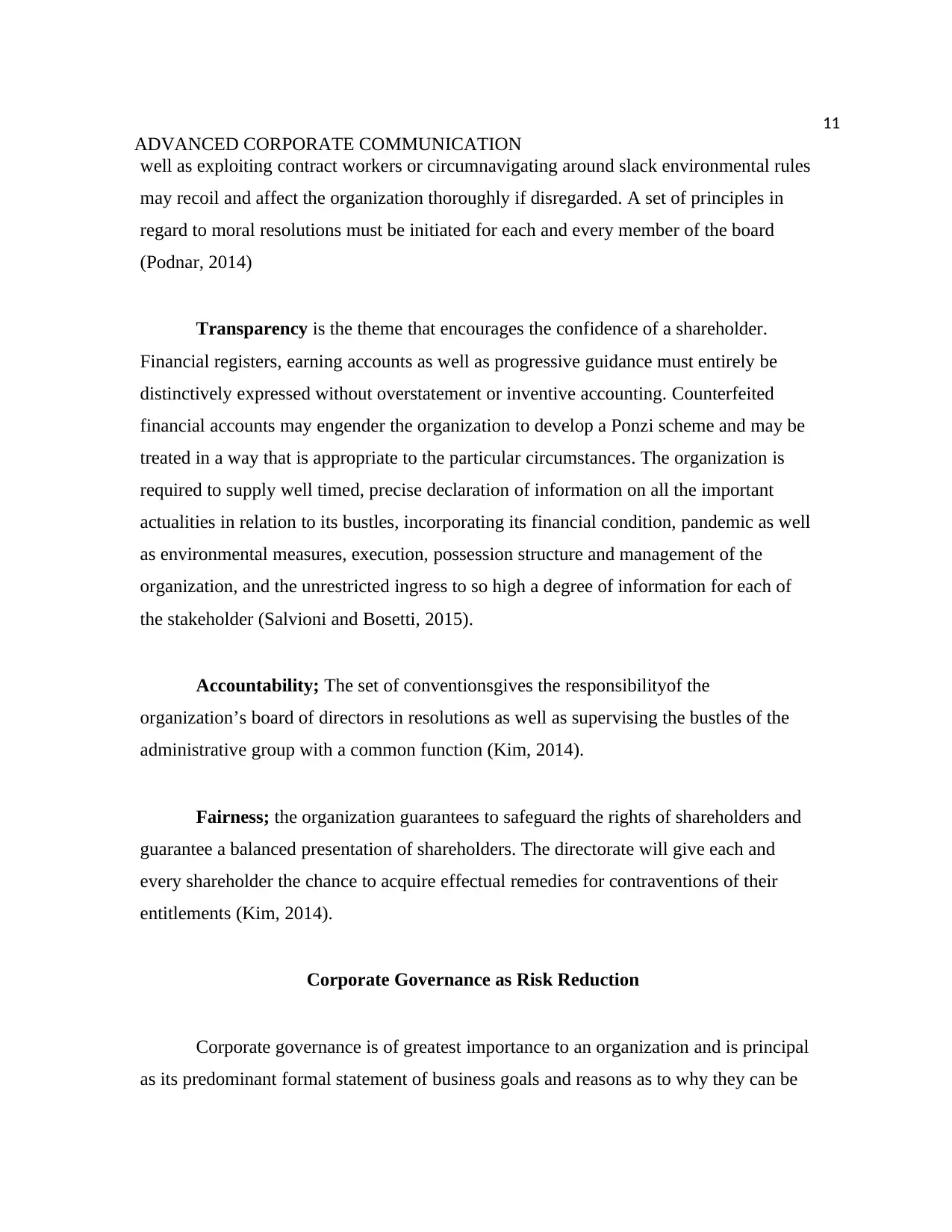
11
ADVANCED CORPORATE COMMUNICATION
well as exploiting contract workers or circumnavigating around slack environmental rules
may recoil and affect the organization thoroughly if disregarded. A set of principles in
regard to moral resolutions must be initiated for each and every member of the board
(Podnar, 2014)
Transparency is the theme that encourages the confidence of a shareholder.
Financial registers, earning accounts as well as progressive guidance must entirely be
distinctively expressed without overstatement or inventive accounting. Counterfeited
financial accounts may engender the organization to develop a Ponzi scheme and may be
treated in a way that is appropriate to the particular circumstances. The organization is
required to supply well timed, precise declaration of information on all the important
actualities in relation to its bustles, incorporating its financial condition, pandemic as well
as environmental measures, execution, possession structure and management of the
organization, and the unrestricted ingress to so high a degree of information for each of
the stakeholder (Salvioni and Bosetti, 2015).
Accountability; The set of conventionsgives the responsibilityof the
organization’s board of directors in resolutions as well as supervising the bustles of the
administrative group with a common function (Kim, 2014).
Fairness; the organization guarantees to safeguard the rights of shareholders and
guarantee a balanced presentation of shareholders. The directorate will give each and
every shareholder the chance to acquire effectual remedies for contraventions of their
entitlements (Kim, 2014).
Corporate Governance as Risk Reduction
Corporate governance is of greatest importance to an organization and is principal
as its predominant formal statement of business goals and reasons as to why they can be
ADVANCED CORPORATE COMMUNICATION
well as exploiting contract workers or circumnavigating around slack environmental rules
may recoil and affect the organization thoroughly if disregarded. A set of principles in
regard to moral resolutions must be initiated for each and every member of the board
(Podnar, 2014)
Transparency is the theme that encourages the confidence of a shareholder.
Financial registers, earning accounts as well as progressive guidance must entirely be
distinctively expressed without overstatement or inventive accounting. Counterfeited
financial accounts may engender the organization to develop a Ponzi scheme and may be
treated in a way that is appropriate to the particular circumstances. The organization is
required to supply well timed, precise declaration of information on all the important
actualities in relation to its bustles, incorporating its financial condition, pandemic as well
as environmental measures, execution, possession structure and management of the
organization, and the unrestricted ingress to so high a degree of information for each of
the stakeholder (Salvioni and Bosetti, 2015).
Accountability; The set of conventionsgives the responsibilityof the
organization’s board of directors in resolutions as well as supervising the bustles of the
administrative group with a common function (Kim, 2014).
Fairness; the organization guarantees to safeguard the rights of shareholders and
guarantee a balanced presentation of shareholders. The directorate will give each and
every shareholder the chance to acquire effectual remedies for contraventions of their
entitlements (Kim, 2014).
Corporate Governance as Risk Reduction
Corporate governance is of greatest importance to an organization and is principal
as its predominant formal statement of business goals and reasons as to why they can be
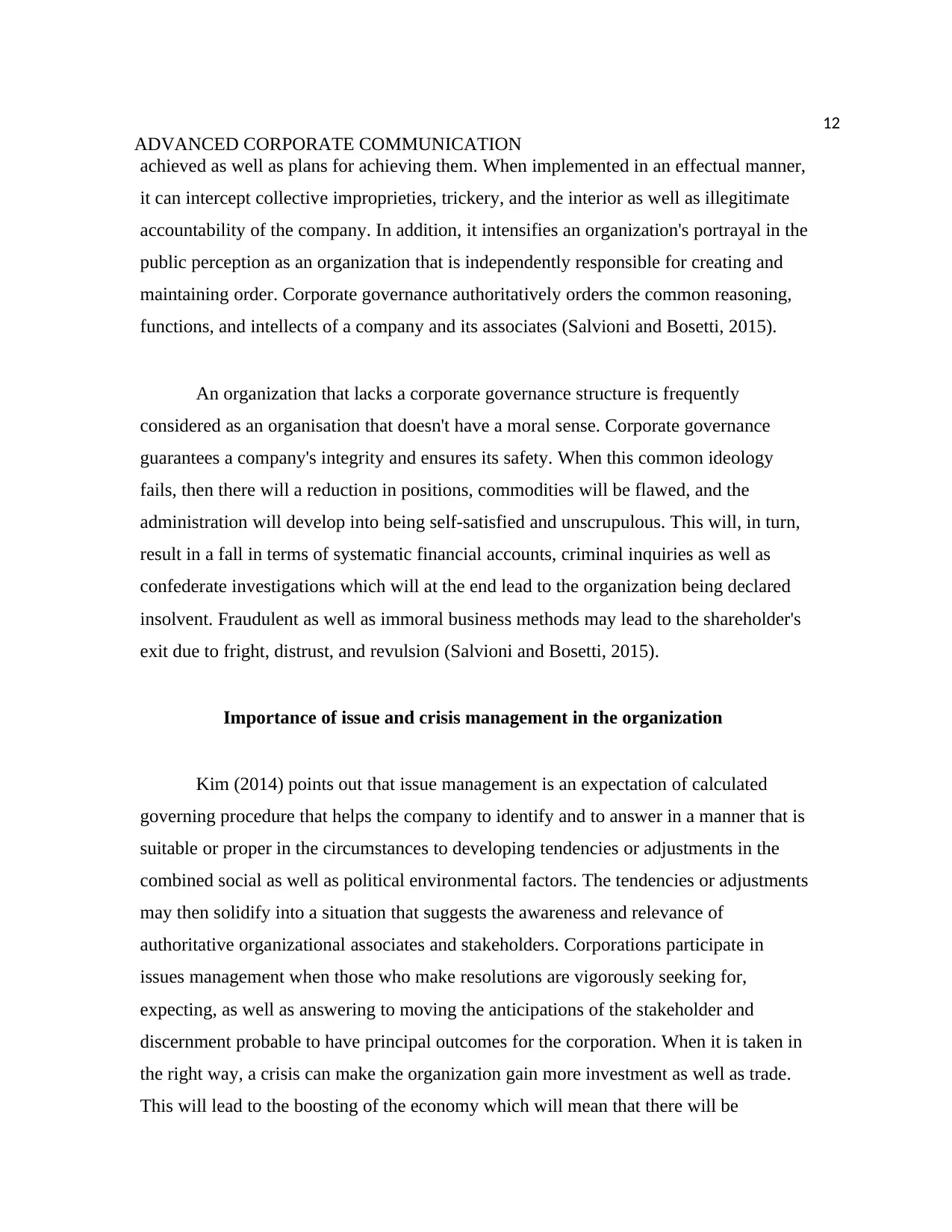
12
ADVANCED CORPORATE COMMUNICATION
achieved as well as plans for achieving them. When implemented in an effectual manner,
it can intercept collective improprieties, trickery, and the interior as well as illegitimate
accountability of the company. In addition, it intensifies an organization's portrayal in the
public perception as an organization that is independently responsible for creating and
maintaining order. Corporate governance authoritatively orders the common reasoning,
functions, and intellects of a company and its associates (Salvioni and Bosetti, 2015).
An organization that lacks a corporate governance structure is frequently
considered as an organisation that doesn't have a moral sense. Corporate governance
guarantees a company's integrity and ensures its safety. When this common ideology
fails, then there will a reduction in positions, commodities will be flawed, and the
administration will develop into being self-satisfied and unscrupulous. This will, in turn,
result in a fall in terms of systematic financial accounts, criminal inquiries as well as
confederate investigations which will at the end lead to the organization being declared
insolvent. Fraudulent as well as immoral business methods may lead to the shareholder's
exit due to fright, distrust, and revulsion (Salvioni and Bosetti, 2015).
Importance of issue and crisis management in the organization
Kim (2014) points out that issue management is an expectation of calculated
governing procedure that helps the company to identify and to answer in a manner that is
suitable or proper in the circumstances to developing tendencies or adjustments in the
combined social as well as political environmental factors. The tendencies or adjustments
may then solidify into a situation that suggests the awareness and relevance of
authoritative organizational associates and stakeholders. Corporations participate in
issues management when those who make resolutions are vigorously seeking for,
expecting, as well as answering to moving the anticipations of the stakeholder and
discernment probable to have principal outcomes for the corporation. When it is taken in
the right way, a crisis can make the organization gain more investment as well as trade.
This will lead to the boosting of the economy which will mean that there will be
ADVANCED CORPORATE COMMUNICATION
achieved as well as plans for achieving them. When implemented in an effectual manner,
it can intercept collective improprieties, trickery, and the interior as well as illegitimate
accountability of the company. In addition, it intensifies an organization's portrayal in the
public perception as an organization that is independently responsible for creating and
maintaining order. Corporate governance authoritatively orders the common reasoning,
functions, and intellects of a company and its associates (Salvioni and Bosetti, 2015).
An organization that lacks a corporate governance structure is frequently
considered as an organisation that doesn't have a moral sense. Corporate governance
guarantees a company's integrity and ensures its safety. When this common ideology
fails, then there will a reduction in positions, commodities will be flawed, and the
administration will develop into being self-satisfied and unscrupulous. This will, in turn,
result in a fall in terms of systematic financial accounts, criminal inquiries as well as
confederate investigations which will at the end lead to the organization being declared
insolvent. Fraudulent as well as immoral business methods may lead to the shareholder's
exit due to fright, distrust, and revulsion (Salvioni and Bosetti, 2015).
Importance of issue and crisis management in the organization
Kim (2014) points out that issue management is an expectation of calculated
governing procedure that helps the company to identify and to answer in a manner that is
suitable or proper in the circumstances to developing tendencies or adjustments in the
combined social as well as political environmental factors. The tendencies or adjustments
may then solidify into a situation that suggests the awareness and relevance of
authoritative organizational associates and stakeholders. Corporations participate in
issues management when those who make resolutions are vigorously seeking for,
expecting, as well as answering to moving the anticipations of the stakeholder and
discernment probable to have principal outcomes for the corporation. When it is taken in
the right way, a crisis can make the organization gain more investment as well as trade.
This will lead to the boosting of the economy which will mean that there will be
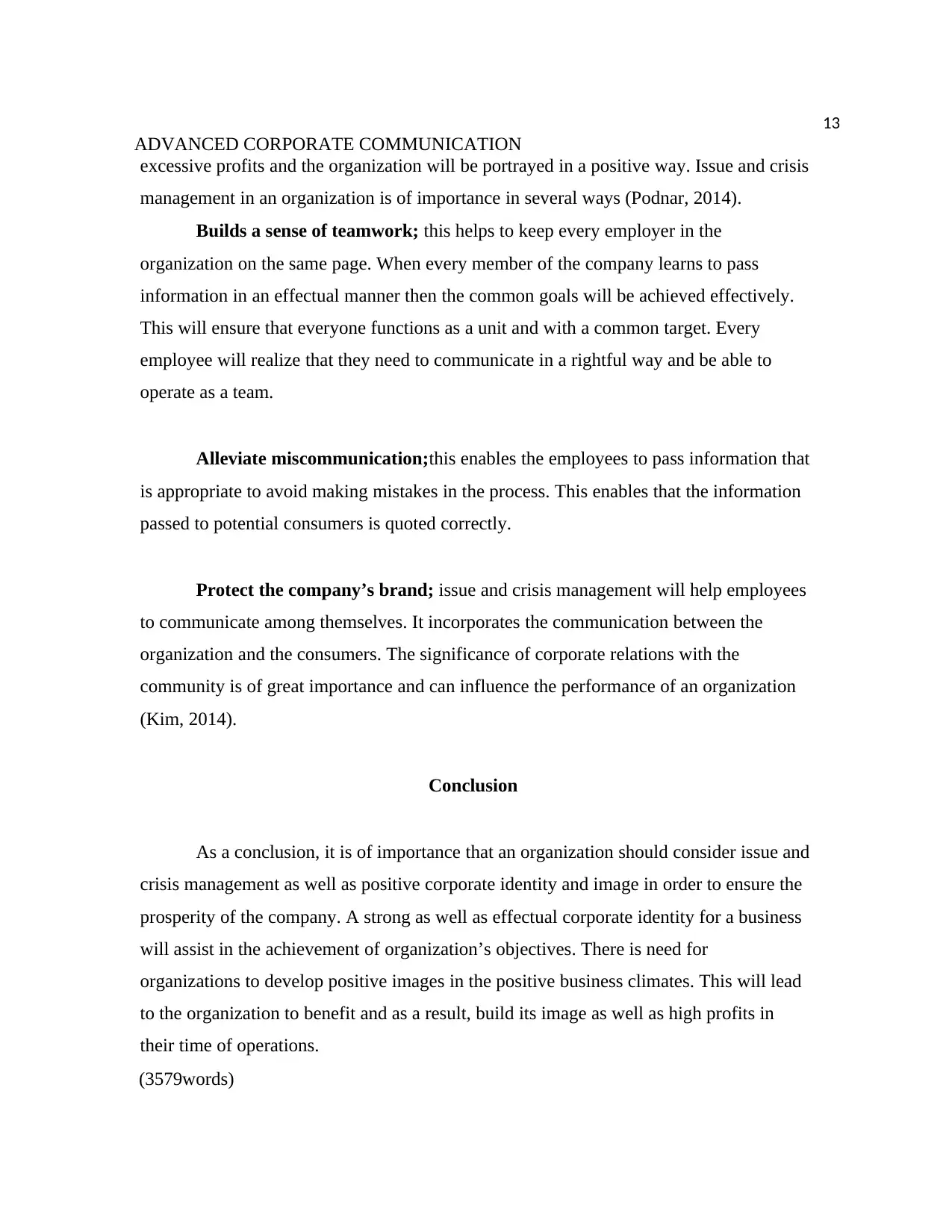
13
ADVANCED CORPORATE COMMUNICATION
excessive profits and the organization will be portrayed in a positive way. Issue and crisis
management in an organization is of importance in several ways (Podnar, 2014).
Builds a sense of teamwork; this helps to keep every employer in the
organization on the same page. When every member of the company learns to pass
information in an effectual manner then the common goals will be achieved effectively.
This will ensure that everyone functions as a unit and with a common target. Every
employee will realize that they need to communicate in a rightful way and be able to
operate as a team.
Alleviate miscommunication;this enables the employees to pass information that
is appropriate to avoid making mistakes in the process. This enables that the information
passed to potential consumers is quoted correctly.
Protect the company’s brand; issue and crisis management will help employees
to communicate among themselves. It incorporates the communication between the
organization and the consumers. The significance of corporate relations with the
community is of great importance and can influence the performance of an organization
(Kim, 2014).
Conclusion
As a conclusion, it is of importance that an organization should consider issue and
crisis management as well as positive corporate identity and image in order to ensure the
prosperity of the company. A strong as well as effectual corporate identity for a business
will assist in the achievement of organization’s objectives. There is need for
organizations to develop positive images in the positive business climates. This will lead
to the organization to benefit and as a result, build its image as well as high profits in
their time of operations.
(3579words)
ADVANCED CORPORATE COMMUNICATION
excessive profits and the organization will be portrayed in a positive way. Issue and crisis
management in an organization is of importance in several ways (Podnar, 2014).
Builds a sense of teamwork; this helps to keep every employer in the
organization on the same page. When every member of the company learns to pass
information in an effectual manner then the common goals will be achieved effectively.
This will ensure that everyone functions as a unit and with a common target. Every
employee will realize that they need to communicate in a rightful way and be able to
operate as a team.
Alleviate miscommunication;this enables the employees to pass information that
is appropriate to avoid making mistakes in the process. This enables that the information
passed to potential consumers is quoted correctly.
Protect the company’s brand; issue and crisis management will help employees
to communicate among themselves. It incorporates the communication between the
organization and the consumers. The significance of corporate relations with the
community is of great importance and can influence the performance of an organization
(Kim, 2014).
Conclusion
As a conclusion, it is of importance that an organization should consider issue and
crisis management as well as positive corporate identity and image in order to ensure the
prosperity of the company. A strong as well as effectual corporate identity for a business
will assist in the achievement of organization’s objectives. There is need for
organizations to develop positive images in the positive business climates. This will lead
to the organization to benefit and as a result, build its image as well as high profits in
their time of operations.
(3579words)
Paraphrase This Document
Need a fresh take? Get an instant paraphrase of this document with our AI Paraphraser
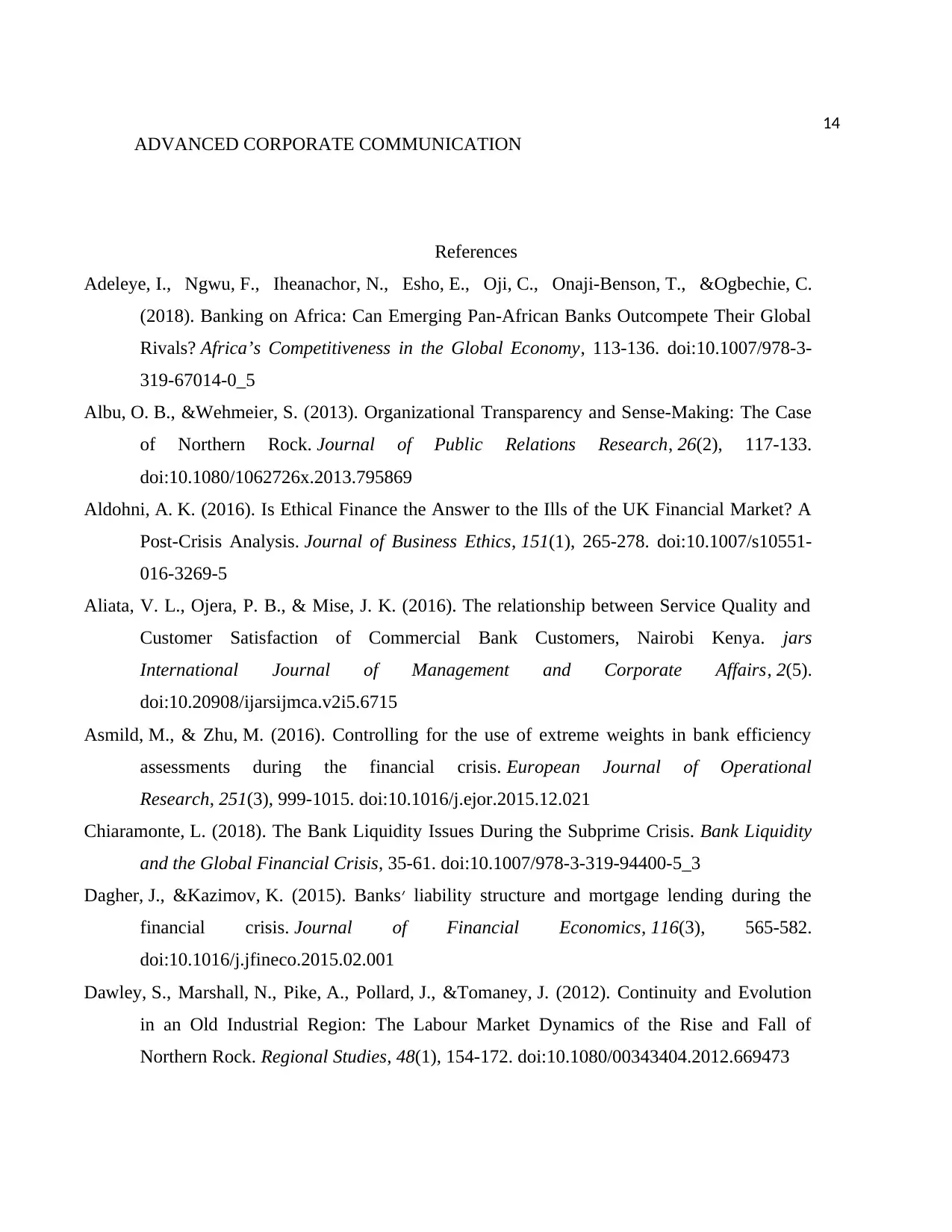
14
ADVANCED CORPORATE COMMUNICATION
References
Adeleye, I., Ngwu, F., Iheanachor, N., Esho, E., Oji, C., Onaji-Benson, T., &Ogbechie, C.
(2018). Banking on Africa: Can Emerging Pan-African Banks Outcompete Their Global
Rivals? Africa’s Competitiveness in the Global Economy, 113-136. doi:10.1007/978-3-
319-67014-0_5
Albu, O. B., &Wehmeier, S. (2013). Organizational Transparency and Sense-Making: The Case
of Northern Rock. Journal of Public Relations Research, 26(2), 117-133.
doi:10.1080/1062726x.2013.795869
Aldohni, A. K. (2016). Is Ethical Finance the Answer to the Ills of the UK Financial Market? A
Post-Crisis Analysis. Journal of Business Ethics, 151(1), 265-278. doi:10.1007/s10551-
016-3269-5
Aliata, V. L., Ojera, P. B., & Mise, J. K. (2016). The relationship between Service Quality and
Customer Satisfaction of Commercial Bank Customers, Nairobi Kenya. jars
International Journal of Management and Corporate Affairs, 2(5).
doi:10.20908/ijarsijmca.v2i5.6715
Asmild, M., & Zhu, M. (2016). Controlling for the use of extreme weights in bank efficiency
assessments during the financial crisis. European Journal of Operational
Research, 251(3), 999-1015. doi:10.1016/j.ejor.2015.12.021
Chiaramonte, L. (2018). The Bank Liquidity Issues During the Subprime Crisis. Bank Liquidity
and the Global Financial Crisis, 35-61. doi:10.1007/978-3-319-94400-5_3
Dagher, J., &Kazimov, K. (2015). Banks׳ liability structure and mortgage lending during the
financial crisis. Journal of Financial Economics, 116(3), 565-582.
doi:10.1016/j.jfineco.2015.02.001
Dawley, S., Marshall, N., Pike, A., Pollard, J., &Tomaney, J. (2012). Continuity and Evolution
in an Old Industrial Region: The Labour Market Dynamics of the Rise and Fall of
Northern Rock. Regional Studies, 48(1), 154-172. doi:10.1080/00343404.2012.669473
ADVANCED CORPORATE COMMUNICATION
References
Adeleye, I., Ngwu, F., Iheanachor, N., Esho, E., Oji, C., Onaji-Benson, T., &Ogbechie, C.
(2018). Banking on Africa: Can Emerging Pan-African Banks Outcompete Their Global
Rivals? Africa’s Competitiveness in the Global Economy, 113-136. doi:10.1007/978-3-
319-67014-0_5
Albu, O. B., &Wehmeier, S. (2013). Organizational Transparency and Sense-Making: The Case
of Northern Rock. Journal of Public Relations Research, 26(2), 117-133.
doi:10.1080/1062726x.2013.795869
Aldohni, A. K. (2016). Is Ethical Finance the Answer to the Ills of the UK Financial Market? A
Post-Crisis Analysis. Journal of Business Ethics, 151(1), 265-278. doi:10.1007/s10551-
016-3269-5
Aliata, V. L., Ojera, P. B., & Mise, J. K. (2016). The relationship between Service Quality and
Customer Satisfaction of Commercial Bank Customers, Nairobi Kenya. jars
International Journal of Management and Corporate Affairs, 2(5).
doi:10.20908/ijarsijmca.v2i5.6715
Asmild, M., & Zhu, M. (2016). Controlling for the use of extreme weights in bank efficiency
assessments during the financial crisis. European Journal of Operational
Research, 251(3), 999-1015. doi:10.1016/j.ejor.2015.12.021
Chiaramonte, L. (2018). The Bank Liquidity Issues During the Subprime Crisis. Bank Liquidity
and the Global Financial Crisis, 35-61. doi:10.1007/978-3-319-94400-5_3
Dagher, J., &Kazimov, K. (2015). Banks׳ liability structure and mortgage lending during the
financial crisis. Journal of Financial Economics, 116(3), 565-582.
doi:10.1016/j.jfineco.2015.02.001
Dawley, S., Marshall, N., Pike, A., Pollard, J., &Tomaney, J. (2012). Continuity and Evolution
in an Old Industrial Region: The Labour Market Dynamics of the Rise and Fall of
Northern Rock. Regional Studies, 48(1), 154-172. doi:10.1080/00343404.2012.669473
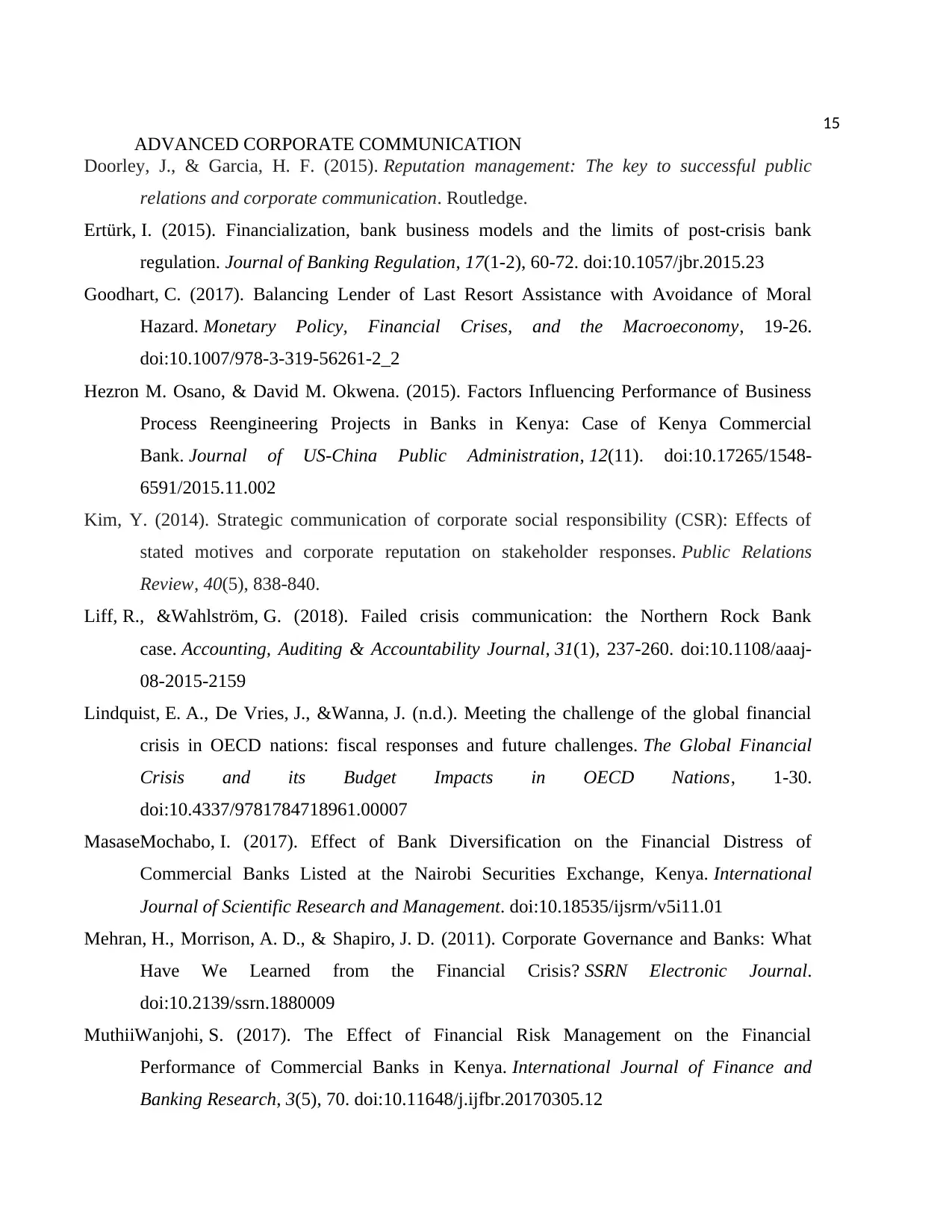
15
ADVANCED CORPORATE COMMUNICATION
Doorley, J., & Garcia, H. F. (2015). Reputation management: The key to successful public
relations and corporate communication. Routledge.
Ertürk, I. (2015). Financialization, bank business models and the limits of post-crisis bank
regulation. Journal of Banking Regulation, 17(1-2), 60-72. doi:10.1057/jbr.2015.23
Goodhart, C. (2017). Balancing Lender of Last Resort Assistance with Avoidance of Moral
Hazard. Monetary Policy, Financial Crises, and the Macroeconomy, 19-26.
doi:10.1007/978-3-319-56261-2_2
Hezron M. Osano, & David M. Okwena. (2015). Factors Influencing Performance of Business
Process Reengineering Projects in Banks in Kenya: Case of Kenya Commercial
Bank. Journal of US-China Public Administration, 12(11). doi:10.17265/1548-
6591/2015.11.002
Kim, Y. (2014). Strategic communication of corporate social responsibility (CSR): Effects of
stated motives and corporate reputation on stakeholder responses. Public Relations
Review, 40(5), 838-840.
Liff, R., &Wahlström, G. (2018). Failed crisis communication: the Northern Rock Bank
case. Accounting, Auditing & Accountability Journal, 31(1), 237-260. doi:10.1108/aaaj-
08-2015-2159
Lindquist, E. A., De Vries, J., &Wanna, J. (n.d.). Meeting the challenge of the global financial
crisis in OECD nations: fiscal responses and future challenges. The Global Financial
Crisis and its Budget Impacts in OECD Nations, 1-30.
doi:10.4337/9781784718961.00007
MasaseMochabo, I. (2017). Effect of Bank Diversification on the Financial Distress of
Commercial Banks Listed at the Nairobi Securities Exchange, Kenya. International
Journal of Scientific Research and Management. doi:10.18535/ijsrm/v5i11.01
Mehran, H., Morrison, A. D., & Shapiro, J. D. (2011). Corporate Governance and Banks: What
Have We Learned from the Financial Crisis? SSRN Electronic Journal.
doi:10.2139/ssrn.1880009
MuthiiWanjohi, S. (2017). The Effect of Financial Risk Management on the Financial
Performance of Commercial Banks in Kenya. International Journal of Finance and
Banking Research, 3(5), 70. doi:10.11648/j.ijfbr.20170305.12
ADVANCED CORPORATE COMMUNICATION
Doorley, J., & Garcia, H. F. (2015). Reputation management: The key to successful public
relations and corporate communication. Routledge.
Ertürk, I. (2015). Financialization, bank business models and the limits of post-crisis bank
regulation. Journal of Banking Regulation, 17(1-2), 60-72. doi:10.1057/jbr.2015.23
Goodhart, C. (2017). Balancing Lender of Last Resort Assistance with Avoidance of Moral
Hazard. Monetary Policy, Financial Crises, and the Macroeconomy, 19-26.
doi:10.1007/978-3-319-56261-2_2
Hezron M. Osano, & David M. Okwena. (2015). Factors Influencing Performance of Business
Process Reengineering Projects in Banks in Kenya: Case of Kenya Commercial
Bank. Journal of US-China Public Administration, 12(11). doi:10.17265/1548-
6591/2015.11.002
Kim, Y. (2014). Strategic communication of corporate social responsibility (CSR): Effects of
stated motives and corporate reputation on stakeholder responses. Public Relations
Review, 40(5), 838-840.
Liff, R., &Wahlström, G. (2018). Failed crisis communication: the Northern Rock Bank
case. Accounting, Auditing & Accountability Journal, 31(1), 237-260. doi:10.1108/aaaj-
08-2015-2159
Lindquist, E. A., De Vries, J., &Wanna, J. (n.d.). Meeting the challenge of the global financial
crisis in OECD nations: fiscal responses and future challenges. The Global Financial
Crisis and its Budget Impacts in OECD Nations, 1-30.
doi:10.4337/9781784718961.00007
MasaseMochabo, I. (2017). Effect of Bank Diversification on the Financial Distress of
Commercial Banks Listed at the Nairobi Securities Exchange, Kenya. International
Journal of Scientific Research and Management. doi:10.18535/ijsrm/v5i11.01
Mehran, H., Morrison, A. D., & Shapiro, J. D. (2011). Corporate Governance and Banks: What
Have We Learned from the Financial Crisis? SSRN Electronic Journal.
doi:10.2139/ssrn.1880009
MuthiiWanjohi, S. (2017). The Effect of Financial Risk Management on the Financial
Performance of Commercial Banks in Kenya. International Journal of Finance and
Banking Research, 3(5), 70. doi:10.11648/j.ijfbr.20170305.12
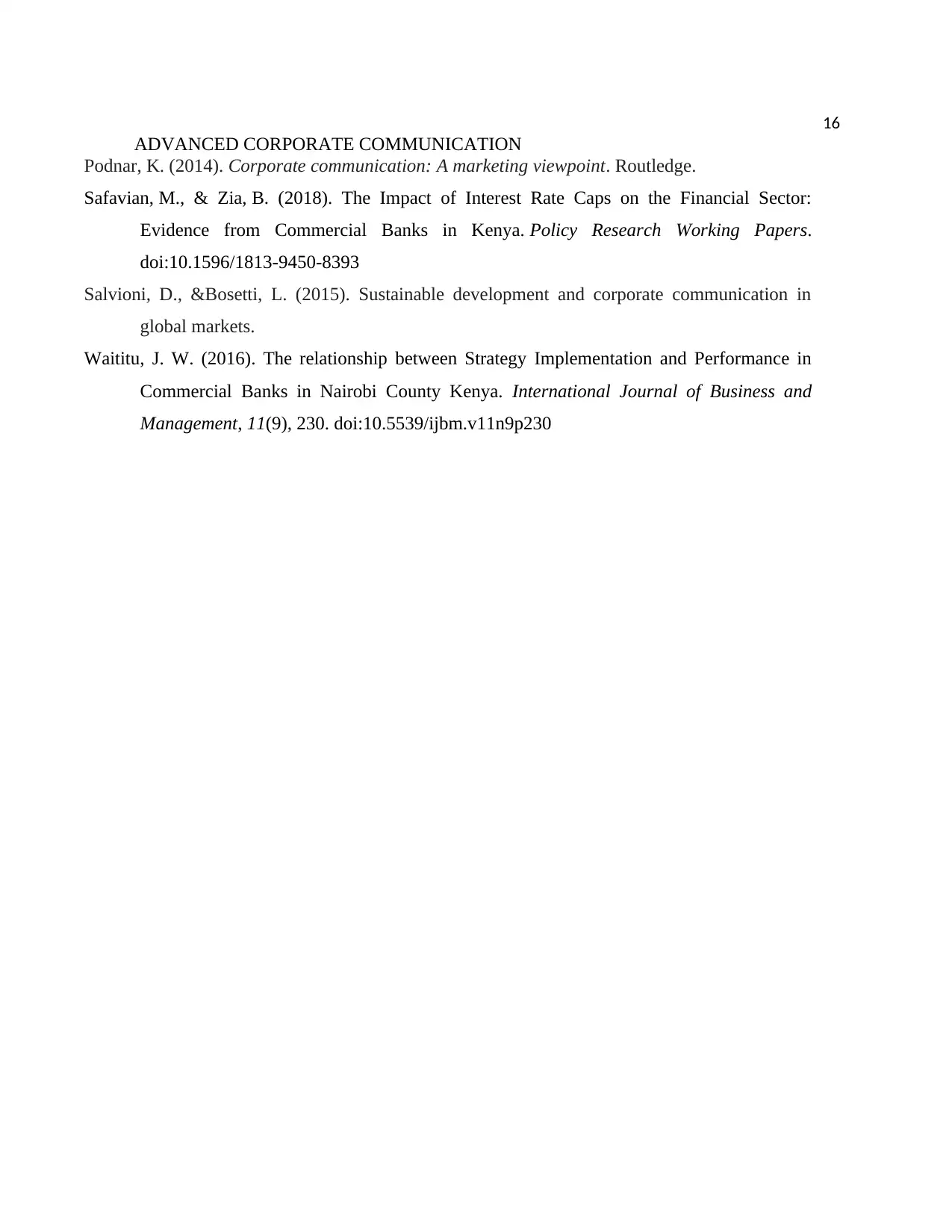
16
ADVANCED CORPORATE COMMUNICATION
Podnar, K. (2014). Corporate communication: A marketing viewpoint. Routledge.
Safavian, M., & Zia, B. (2018). The Impact of Interest Rate Caps on the Financial Sector:
Evidence from Commercial Banks in Kenya. Policy Research Working Papers.
doi:10.1596/1813-9450-8393
Salvioni, D., &Bosetti, L. (2015). Sustainable development and corporate communication in
global markets.
Waititu, J. W. (2016). The relationship between Strategy Implementation and Performance in
Commercial Banks in Nairobi County Kenya. International Journal of Business and
Management, 11(9), 230. doi:10.5539/ijbm.v11n9p230
ADVANCED CORPORATE COMMUNICATION
Podnar, K. (2014). Corporate communication: A marketing viewpoint. Routledge.
Safavian, M., & Zia, B. (2018). The Impact of Interest Rate Caps on the Financial Sector:
Evidence from Commercial Banks in Kenya. Policy Research Working Papers.
doi:10.1596/1813-9450-8393
Salvioni, D., &Bosetti, L. (2015). Sustainable development and corporate communication in
global markets.
Waititu, J. W. (2016). The relationship between Strategy Implementation and Performance in
Commercial Banks in Nairobi County Kenya. International Journal of Business and
Management, 11(9), 230. doi:10.5539/ijbm.v11n9p230
1 out of 16
Your All-in-One AI-Powered Toolkit for Academic Success.
+13062052269
info@desklib.com
Available 24*7 on WhatsApp / Email
![[object Object]](/_next/static/media/star-bottom.7253800d.svg)
Unlock your academic potential
© 2024 | Zucol Services PVT LTD | All rights reserved.


